1lumen selects and reviews products personally. We may earn affiliate commissions through our links, which help support our testing.
Lumintop Mach review
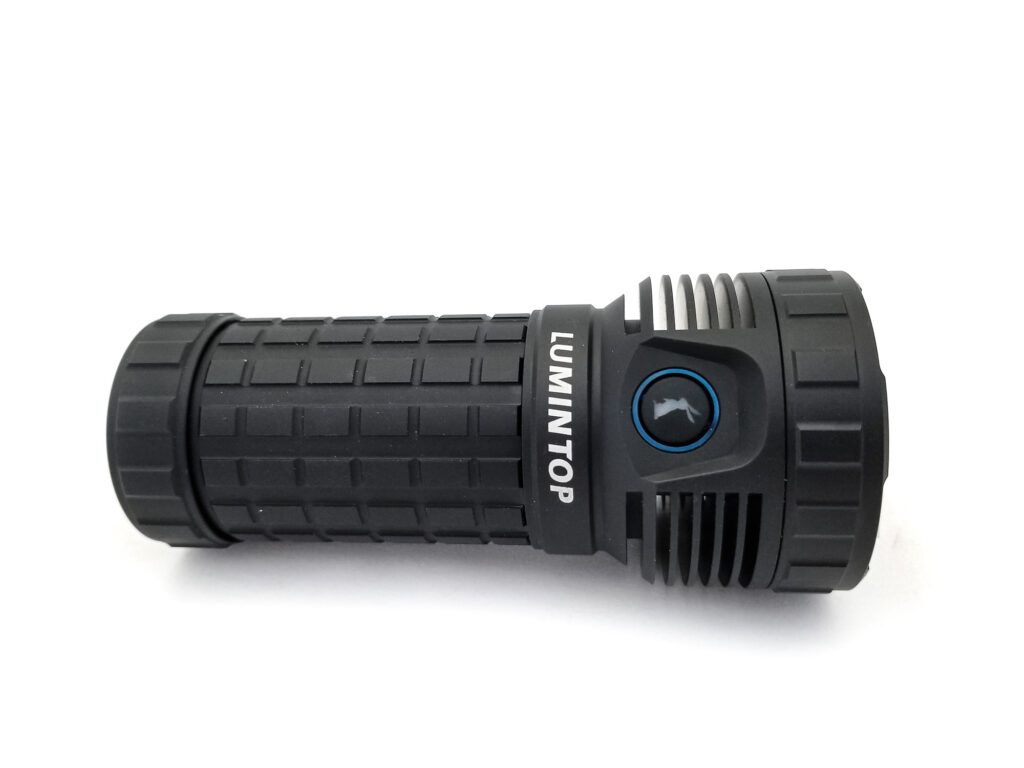
Lumintop Mach specs
| Brand & Model | Lumintop Mach |
|---|---|
| Flashlight category | Lumenmonster |
| LED | 8 Cree XHP50.2 HD |
| Max. output | 26,000 lumens |
| Max. beam distance | 520 meters |
| Max. beam intensity | 67,500 cd |
| Battery config. | 3 * 21700 |
| Onboard charging | USB type C with Power Bank |
| Main modes | 4 (and ramping) |
| Blinkies | Strobe, SOS, Beacon |
| Waterproof | IP68 |
| Review publication date | June 2023 |
Review intro:
When LEDs hit the market (the mass market), a lot of products and industries benefited. LEDs consumed significantly less energy to produce an equivalent amount of light as an incandescent bulb, generated less heat, and were smaller. The industry that benefited most? Lighting, in particular, portable lighting, which helped spawn an endless variety of portable LED lighting products ranging from the ultra cheap, throw-away lights, to barely-usable lights that can light up a football field, to fancy ones that cost an arm, leg, or kidney.
The culmination of all this diversification is our review subject today, the Lumintop Mach. Lumintop Technology Co. Limited has been a major player in the flashlight game for years, and have brought us some portable lighting tools which bridge the gap between practical and ridiculous, all at an affordable price. Lumintop’s appeal extends into mainstream and the enthusiast sectors, with some of their most memorable and popular models directed towards those with more flashlights than they know what to do with.
On with the show.
The Lumintop Mach is a brand-new flashlight, and more importantly, represents a feature never before seen on a Lumintop light, and one that’s becoming more mainstream: Active cooling. In the past, if you wanted to improve sustained output on very powerful lights, you needed to make them huge, with lots of thermal mass, which made them heavy and bulky. Imalent changed that, introducing active cooling on their MS-series lights with little fans that extracted heat to help improve output.
Imalent has owned the market on active cooling. Mateminco joined in with the ‘fandle’ (a handle with a fan inside) equipped MT90 Plus, followed by Manker’s MK38, also sporting a fandle. Acebeam was one of the first with an external fan on the X70, but followed suit with their internal fan cooled X75, and finally a pocketable light that could sustain a bonafide 2000 Lumens for 1 hour in the Wuben X1. Now Lumintop has joined the ‘fan’ club with the Mach.
The specs? 26,000 Lumens, 500+ meters of throw, a simple UI, PD charging and power bank. It promises 8,000 sustainable Lumens for 1 hour, and that’s pretty unheard of for a 3*21700 rig weighing 510 grams. It’s also got a very unique design for the fan. I’m skeptical since we know manufacturers like to puff up their specs (but we keep them honest). Oh, and a BIG thanks to our favorite flashlight connoisseur Neal over a nealsgadgets.com for sending this out for review. Thanks Neal!
Package quality.
The Mach came in a non-retailable, utilitarian box with a lift-off lid and specs. Not too much fanfare. Inside, it’s about what I was expecting from Lumintop.
- Lumintop Mach flashlight
- Screw-in swivel stud
- Manual
- USB type C cable
There’s not much here for accessories; just the bare necessities. There’s no batteries, but Neal will sell you some, and I always recommend it since it’s cheaper than buying the separately and Neal supplies good quality batteries. The Mach I received included 3* Molicel P42A li-ion cells that had been fitted with button tops. These are good high current cells, so they should help the Mach chooch along nicely. I highly recommend getting the kit with batteries, since you’ll need button tops, and batteries which can provide at least 25-30 amps of continuous discharge.
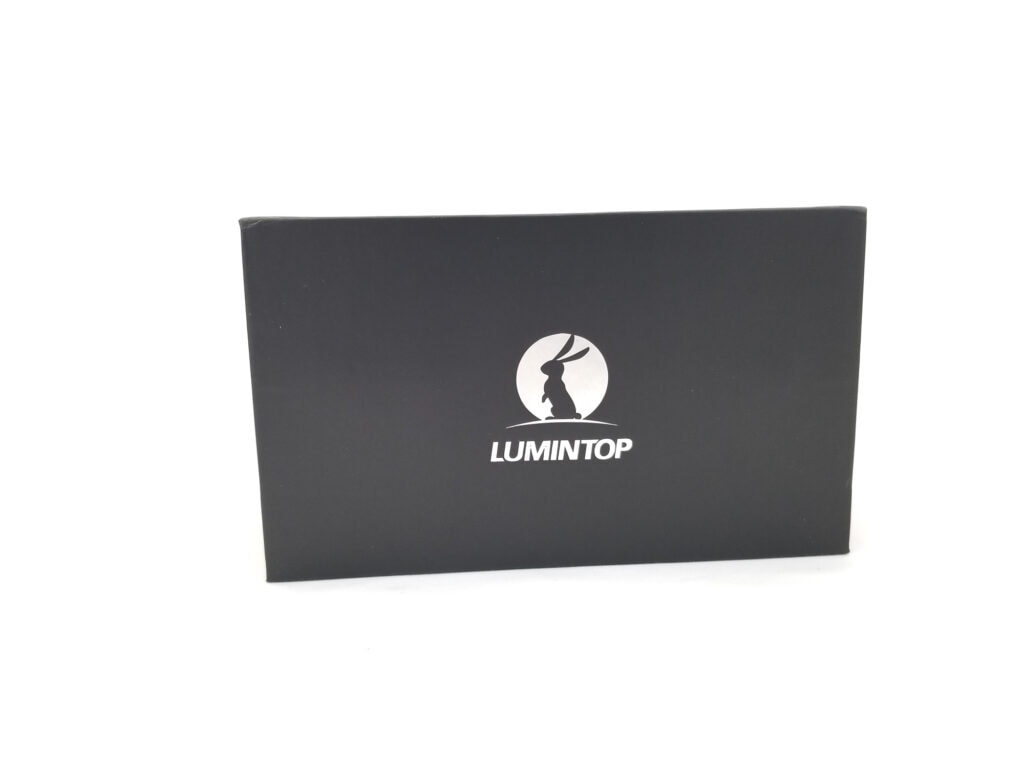
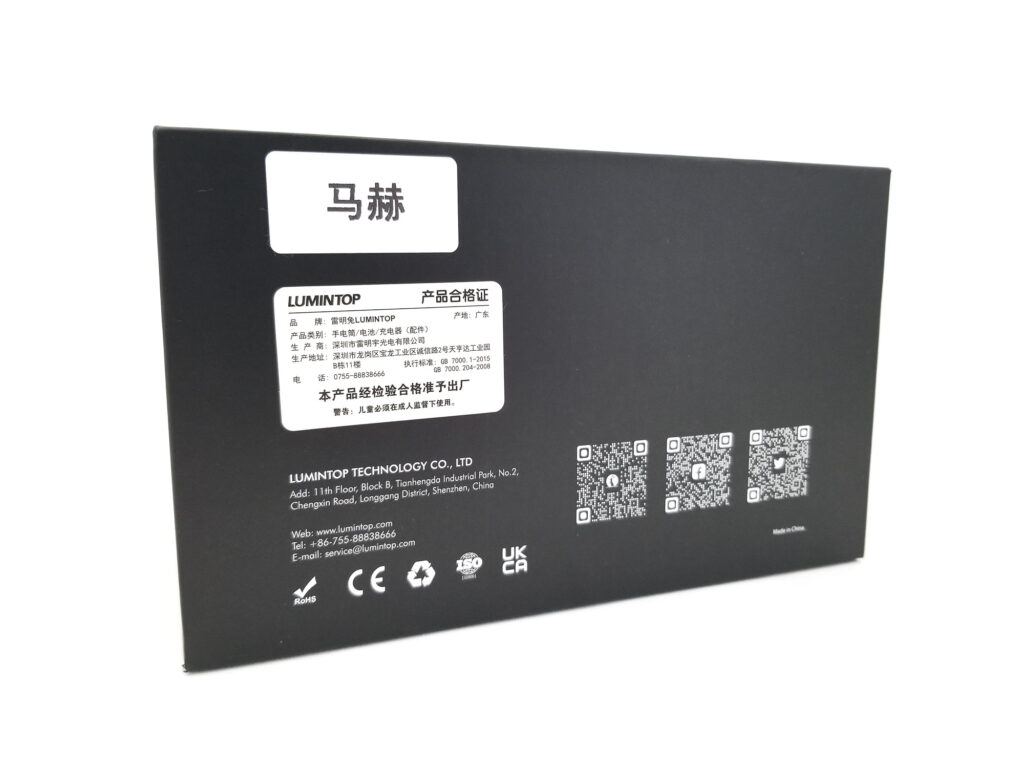
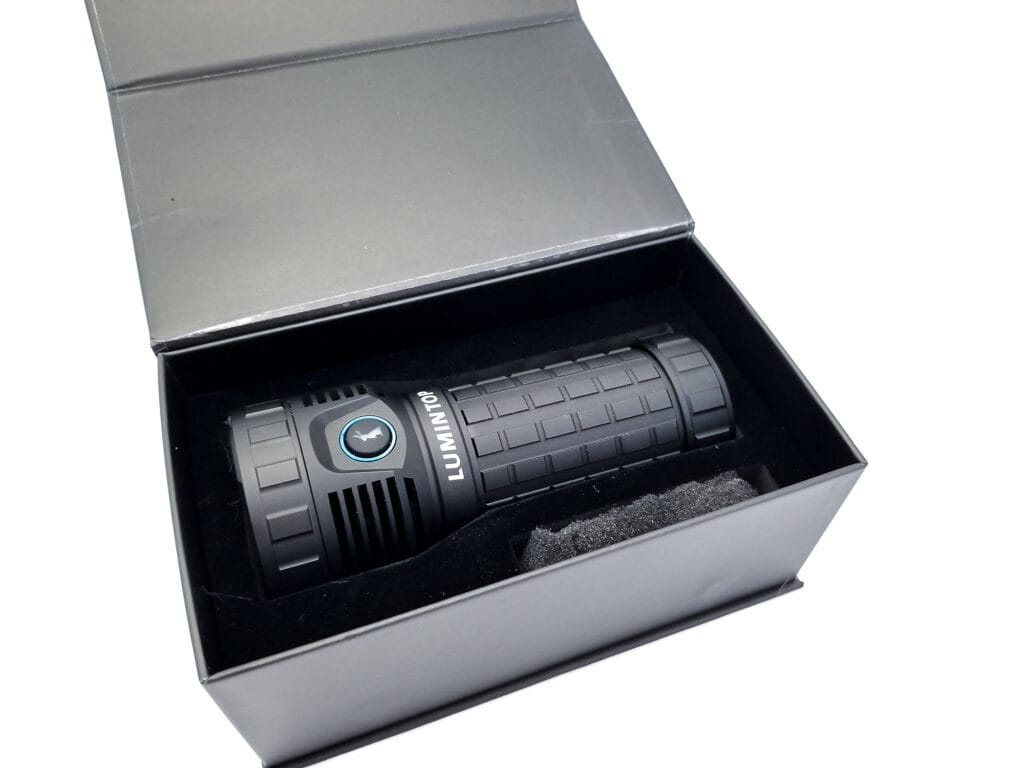
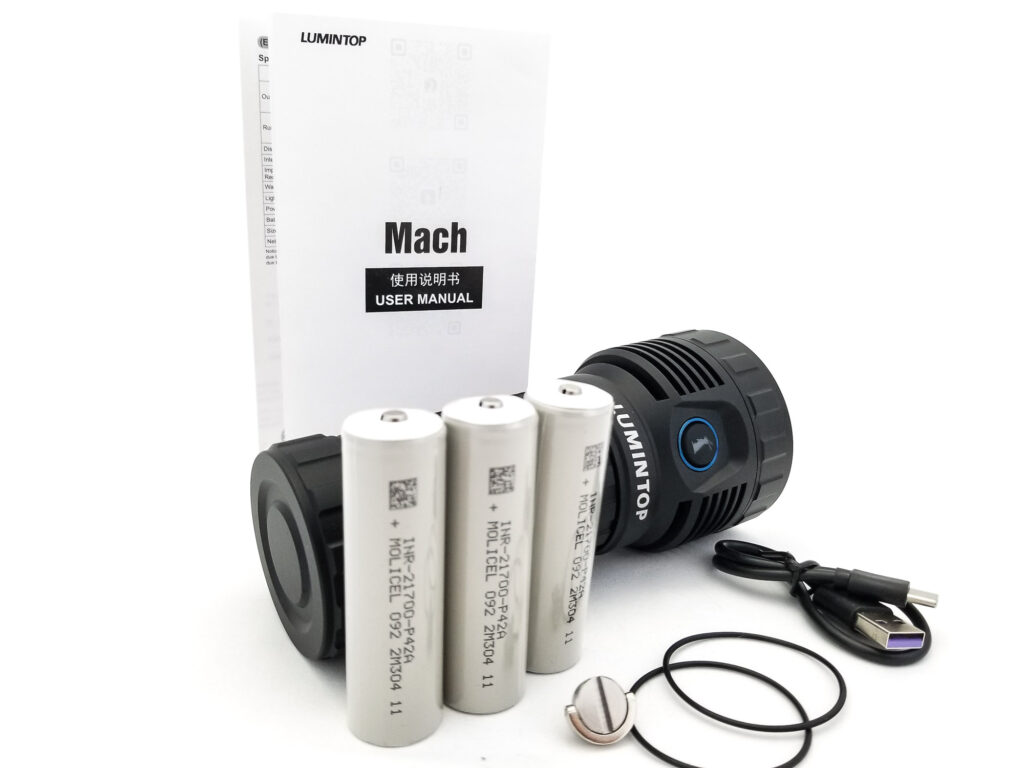
Flashlight in use
The Lumintop Mach is a high output general purpose flashlight. It can make a lot of light and spread it out over a large area with pretty good distance. Before you can make all those Lumens, you need to remove the high tech isolator (actually a torn-off piece of cardstock) sitting on top of the batteries though (if you ordered the Mach with batteries). Although the light does have electronic lockout, it wasn’t activated on my sample light. These types of lights are usually sporting multiple batteries, bulky, and heavy (over 1 lb for the Mach), so pocket carry is out of the question.
The Mach is going to be best toted around in a holster or dangling from a lanyard (neither of which are included). Lumintop does include a screw-in stud with a swiveling bail that threads into a ¼ x 20 threaded mount. This would also be an attachment point for a tripod shoe. It fit fine on my tripod, and I borrowed the strap from the Fenix LR80R for some shoulder carry. I do think a holster would be the best method, so I borrowed the holster from the Thrunite TN50, and it fit fine in there. There’s no other mounting points on the light. The Mach’s form factor is instantly recognizable as the soda or soup can style. These are short, chubby lights with large-diameter bodies.
The battery tube is properly girthy, and while my big meat mitts didn’t have trouble handling it, I’d imagine folks with smaller hands might. That said, Lumintop did an okay job designing the battery tube since it has a lot of squares with abrupt edges that really aids in gripping. In fact, it’s modeled a little bit like the GT3 Pro, and sister light the Thanos 23 (more or less the passive-cooled version of the Mach).
The tailcap has nice polygonal gripping surfaces, and so does the bezel. I’d say every bit as good as traditional knurling. For a big light, it’s pretty maneuverable, but make no mistake; this isn’t an EDC piece, and probably does best riding in a holster. Switching duties are handled by a single e-switch aft of the head. The rubber button has a translucent part shaped like the Lumintop bunny with LEDs behind it for on state charge status and LVP. It’s set in a snazzy blue anodized aluminum bezel.
The switch action isn’t as snappy as some others, but it’s still tactile and audible and the button feels pretty nice. Tail standing is super stable thanks to the very wide, flat tail, perfect for area lighting.
You might be thinking, ‘Nick, tell us about the fan!’
Okay, the star of the show here is of course the built-in cooling fan. This one’s mounted in a hollowed-out area of the head rearward of the LED shelf. The fan sits on brass posts secured to the inner part of the head. It’s similar to what Acebeam does on the X75, and I think this is a good design since it allows the fan to effectively remove the heat from the bottom of the shelf and the adjacent cooling surfaces. The fan draws air in through a snorkel-like part that extends up through the reflector assembly through a hole in the lens.
That’s right, there’s a hole in the lens!
More on that later.
The air is drawn in through the inlet and circulated around the bottom of the LED shelf and over the very deep cooling fins before being exhausted outwards. It’s a good design and keeps the head compact. We’ll see how it works during the runtime tests. There’s no external charge ports on the light, so to access the charging input/output, you need to unscrew the tailcap, which reveals an I/O panel with a segmented LED display, momentary switch, USB type C, and type A sockets for charging input and power bank output. It’s designed so that you don’t have to remove the batteries except to replace them. I really like this concept, since it guarantees water and detritus intrusions are going to be minimized, plus you can swap out the batteries if needed. Thanks Lumintop!

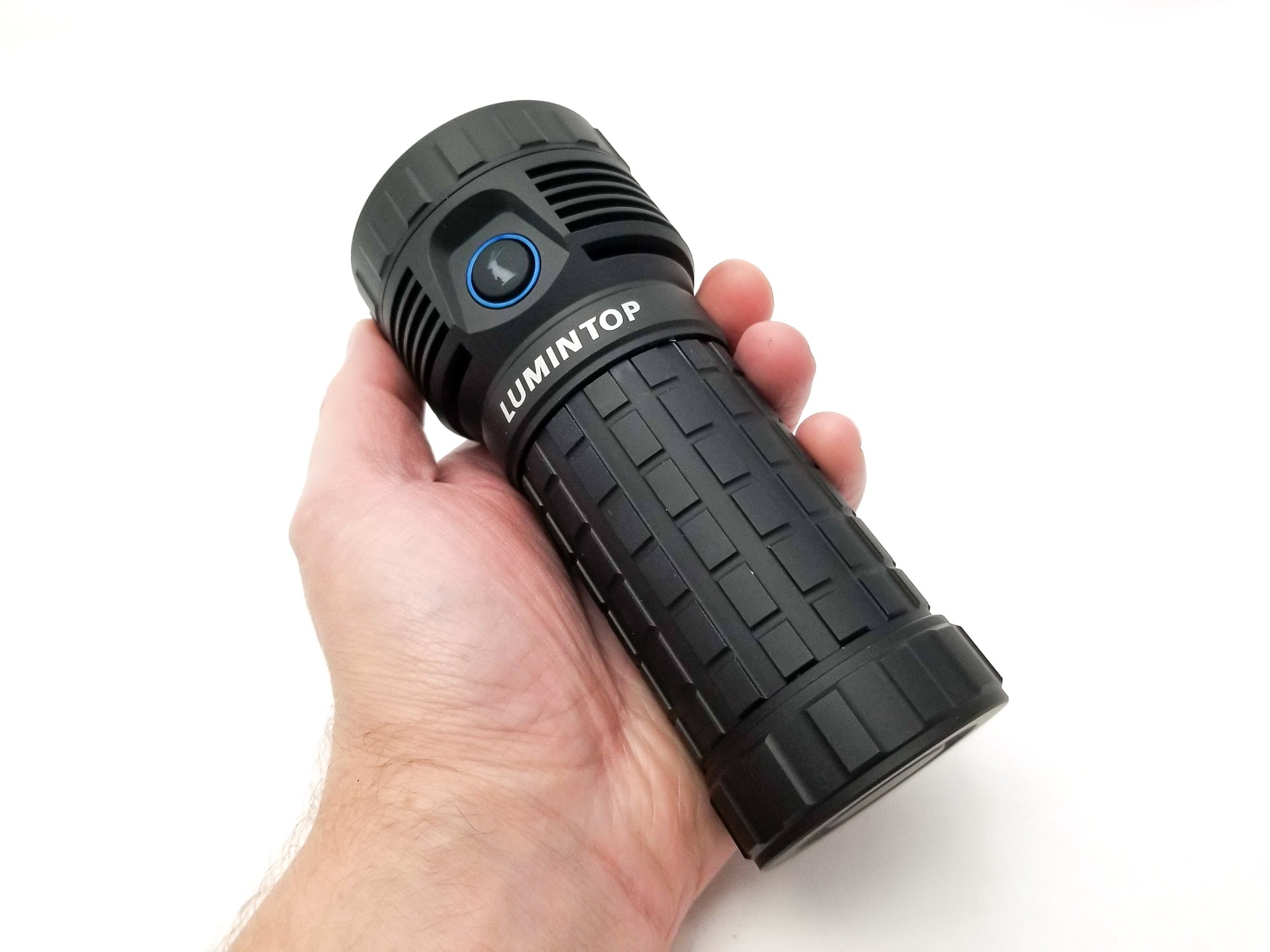
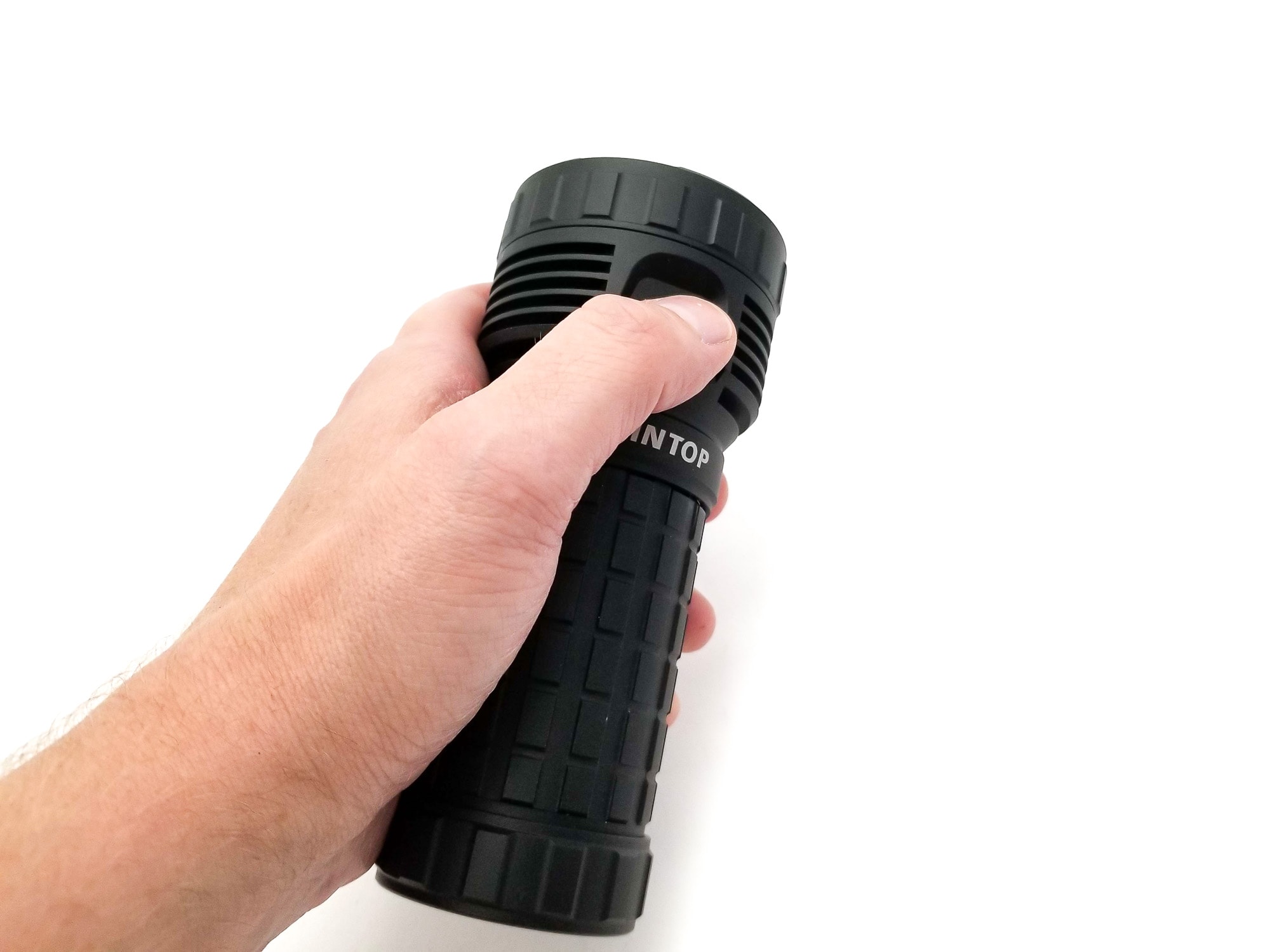
Build Quality and Warranty
I’ve tested a few Lumintop lights, and the survey says they’ve always been really, really nice with no issues with build quality, fit or finish. The Mach is more of the same! The Mach resides in the upper end of the Lumintop catalog, and in keeping, retails for around $280-$315, but coupons and deals out there can bring it down to about $200 (or less). (see below this review for a coupon code)
I’m still trying to figure out how Lumintop can sell this light for that cheap, but that’s good for consumers! For comparison, the competition is generally coming in a hundred to a few hundred bucks more. The Mach is milled from 6061-T6 aerospace aluminum (is that even a thing nowadays?), and the machining is really tidy and defect-free. There weren’t any errant tooling marks or blemishes, and sharp edges are non-existent. All the parts fit up perfectly with no odd gaps or misaligned parts, and I expect that at this price.
The finish? I really like it! It’s available in any color you want as long as it’s black, and the finish is advertised as type III HA hard anodized. It’s pretty grippy, and also free of defects, but I don’t think it’s very tough, since in the limited time I’ve handled the Mach after photographing and other things, there’s already some wear. The threads all around are fully anodized and pretty thick. There wasn’t too much lube on them out of the box, but they were smooth nonetheless.
Still, I’d add some synthetic grease. Everything’s o-ring sealed: The front of the battery tube, charge I/O access cover (aka tailcap), bezel, lens periphery, and the hole in the lens where the air intake for the fan comes through is sealed with a glow in the dark o-ring. The springs in the bottom of the battery tube are very substantial and non magnetic copper alloy for maximum current handling. The driver has brass contact rings for the positive and the ground plane. The tube also has a gold-plated pogo pin sticking out of the top that interfaces with another ring on the back of the driver, probably for the charging function.
For water resistance, Lumintop gives the Mach an IP68 rating. With no external charge port, I believe it. In fact, there is a video from Lumintop floating around the Interweb showing the Mach being submerged, while running, and doing totally fine. While I probably won’t replicate that test, it shows that the Mach has the potential for being completely water resistant.
Warranty? From Lumintop: Lumintop warrants our flashlights to be free from defects in workmanship and materials, including any LEDs housed within, for the lifetime of the original owner. 30-day free replacement: LUMINTOP will replace a new product within 30 days of purchase for any manufacturing defects if problems come into being in normal use; We will replace it with the same model. If the model has been discontinued, customers will receive a product with a similar or improved model. Five-years free repairs: LUMINTOP will offer free repair within 60 months for lights from the date of purchase if the problem develops with normal use. Lifetime warranty: If repair is required after guaranty period, we’ll charge for parts accordingly.
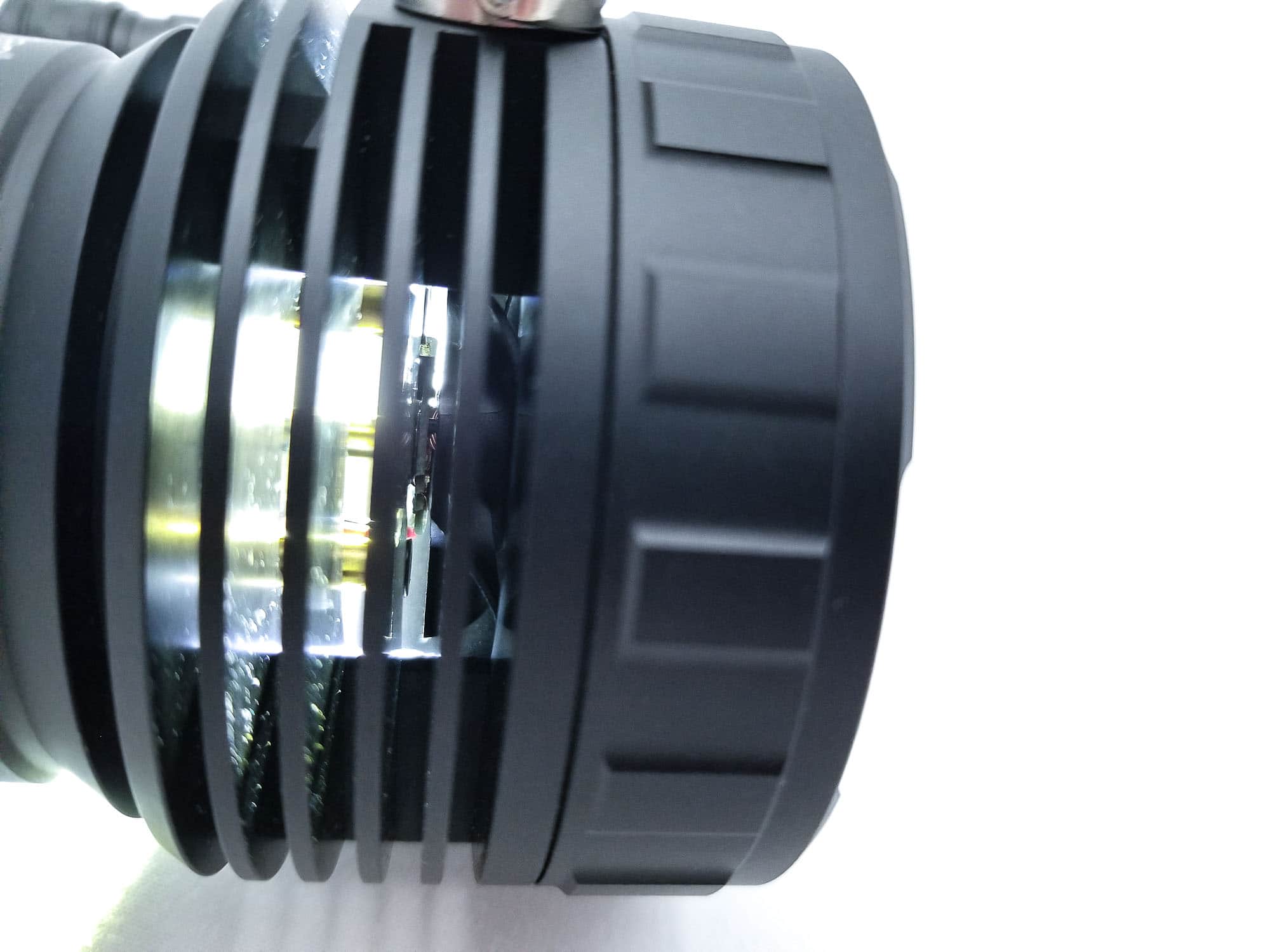
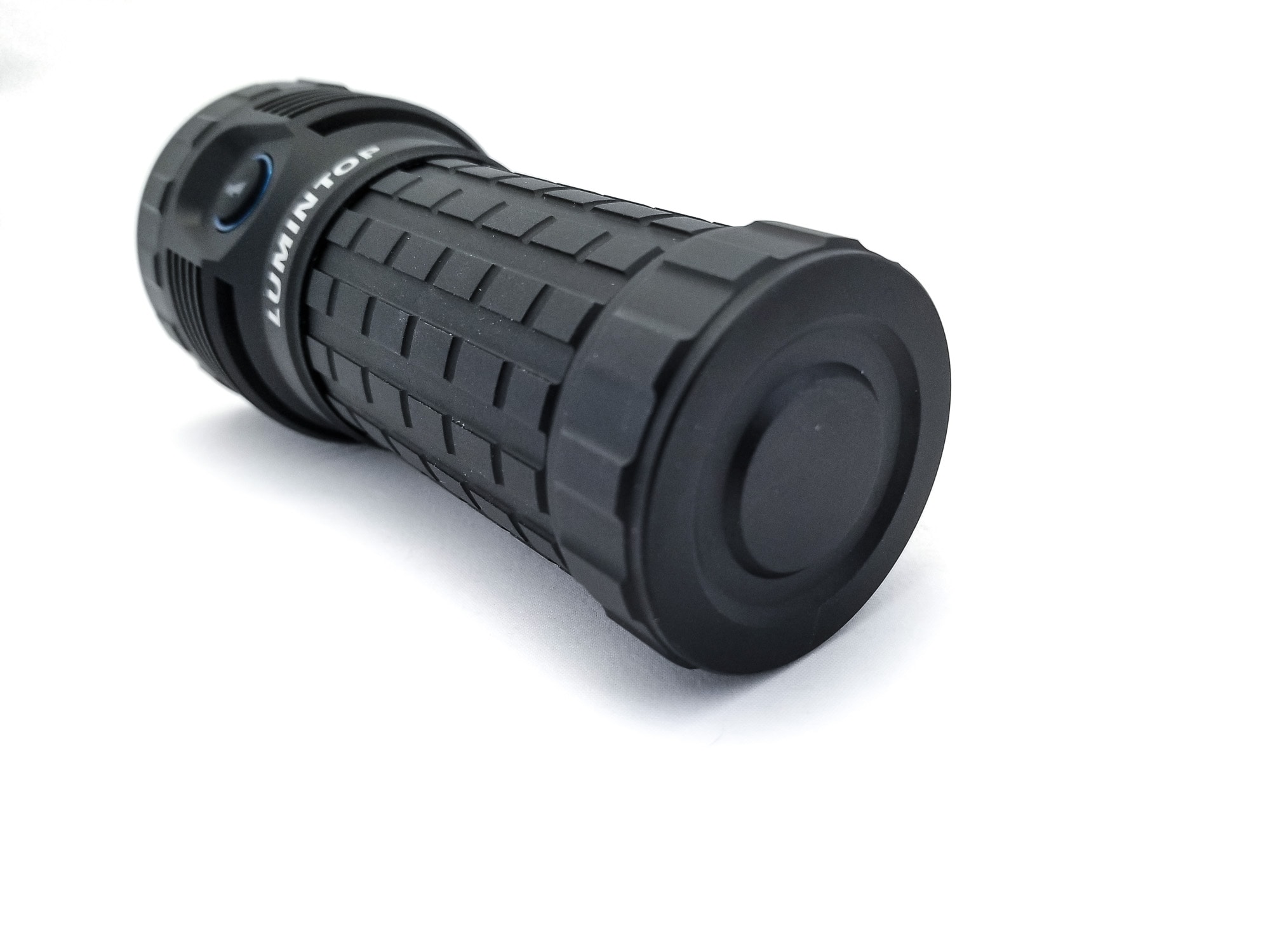
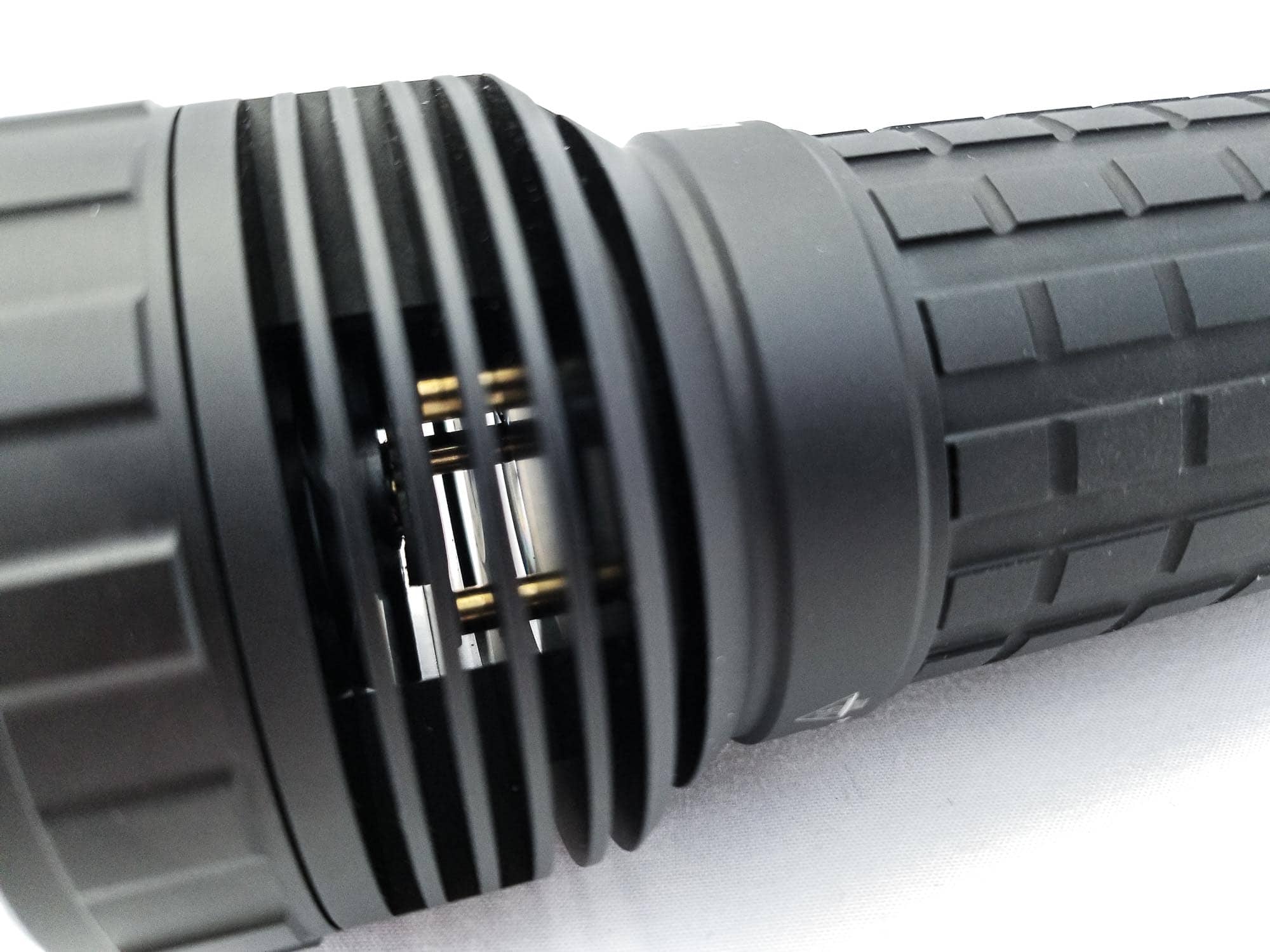
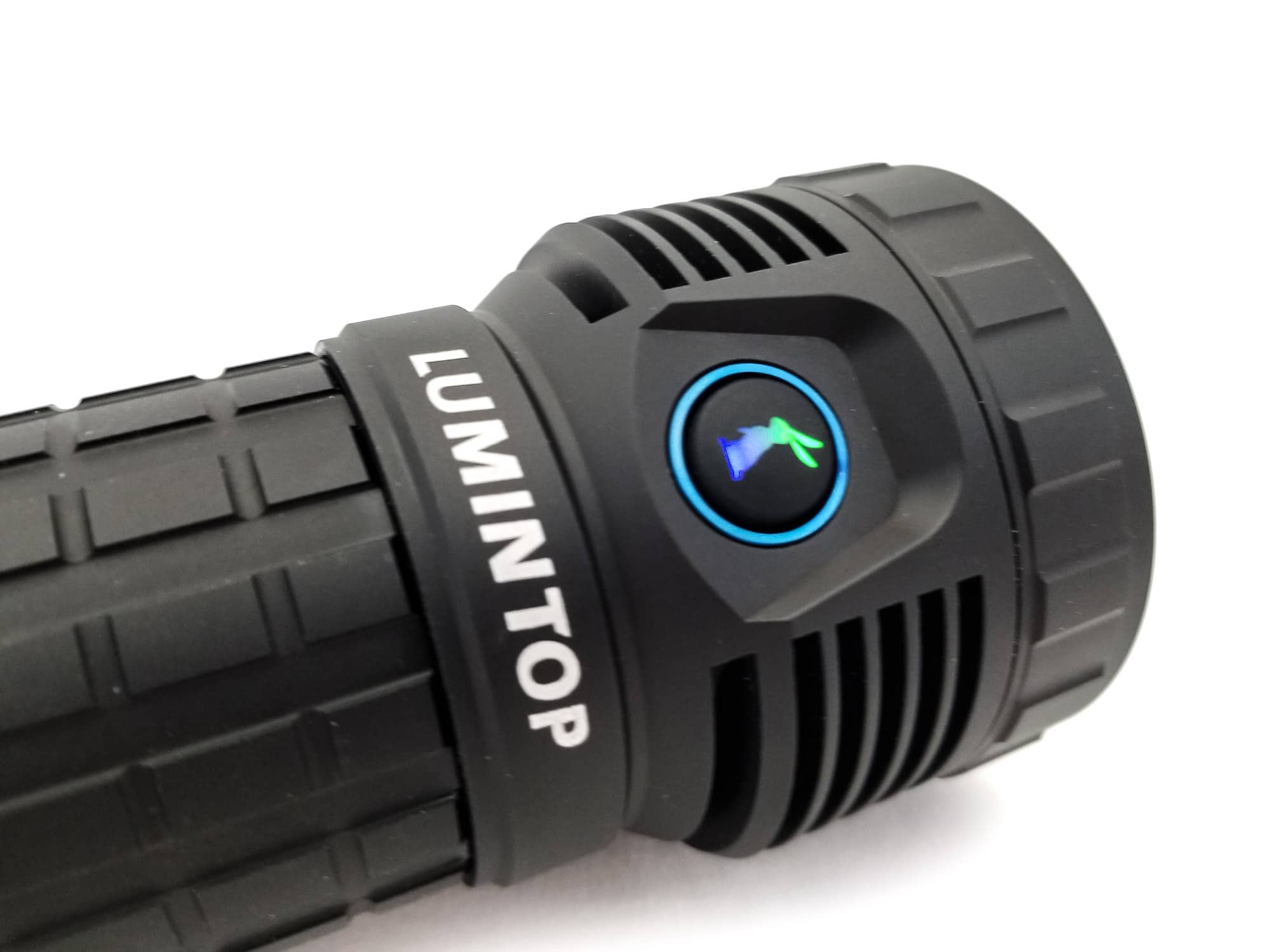
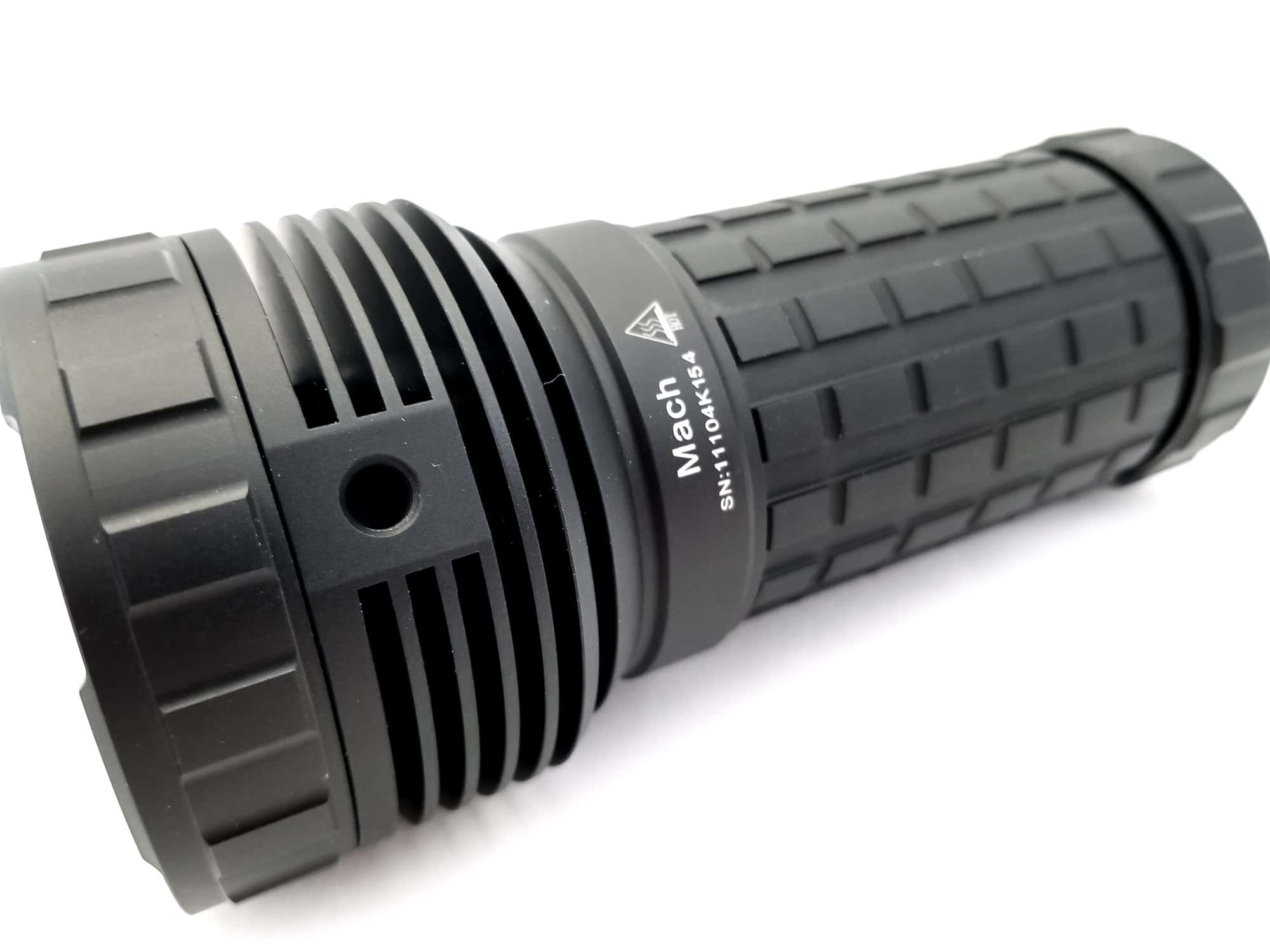
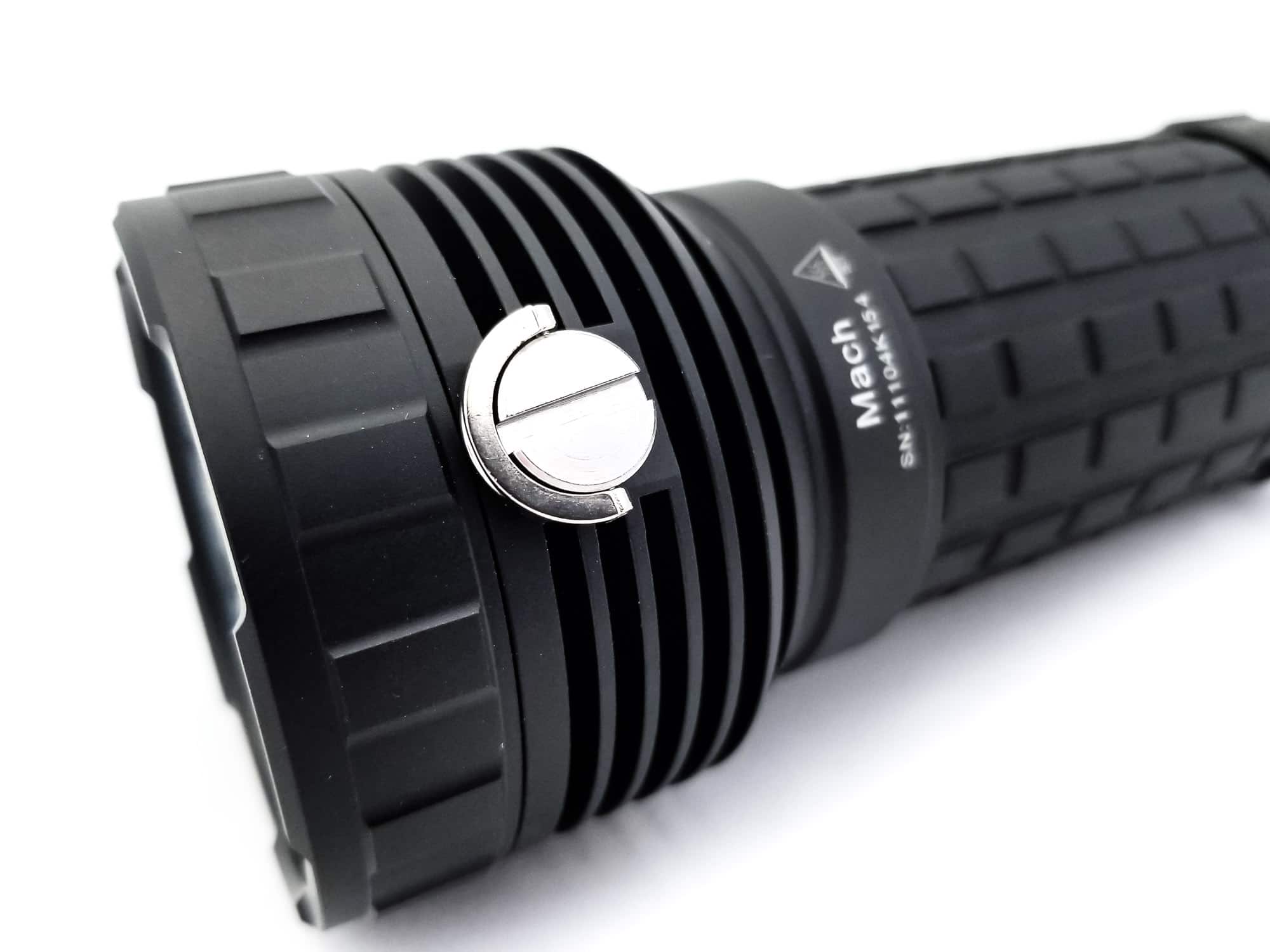
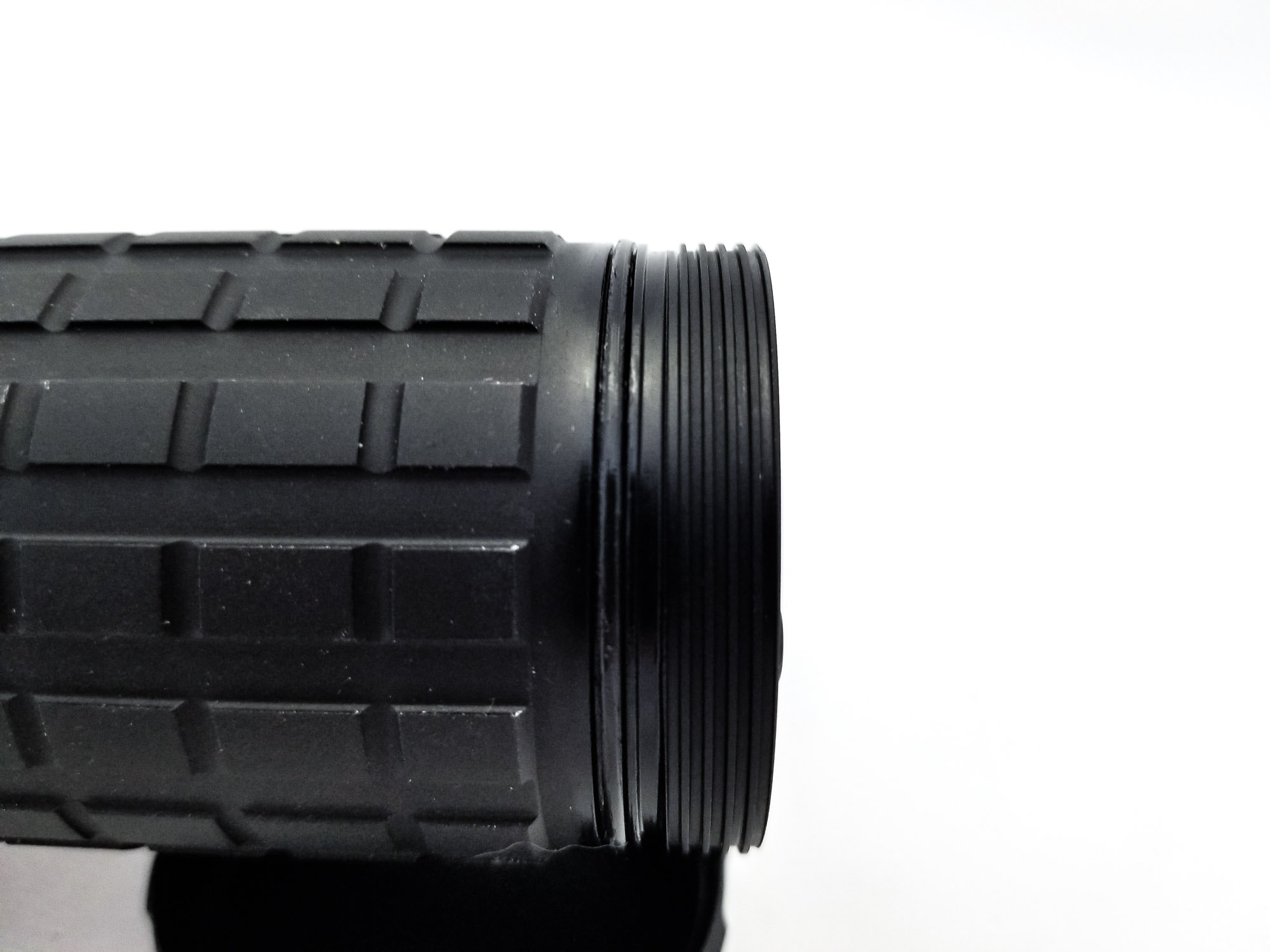
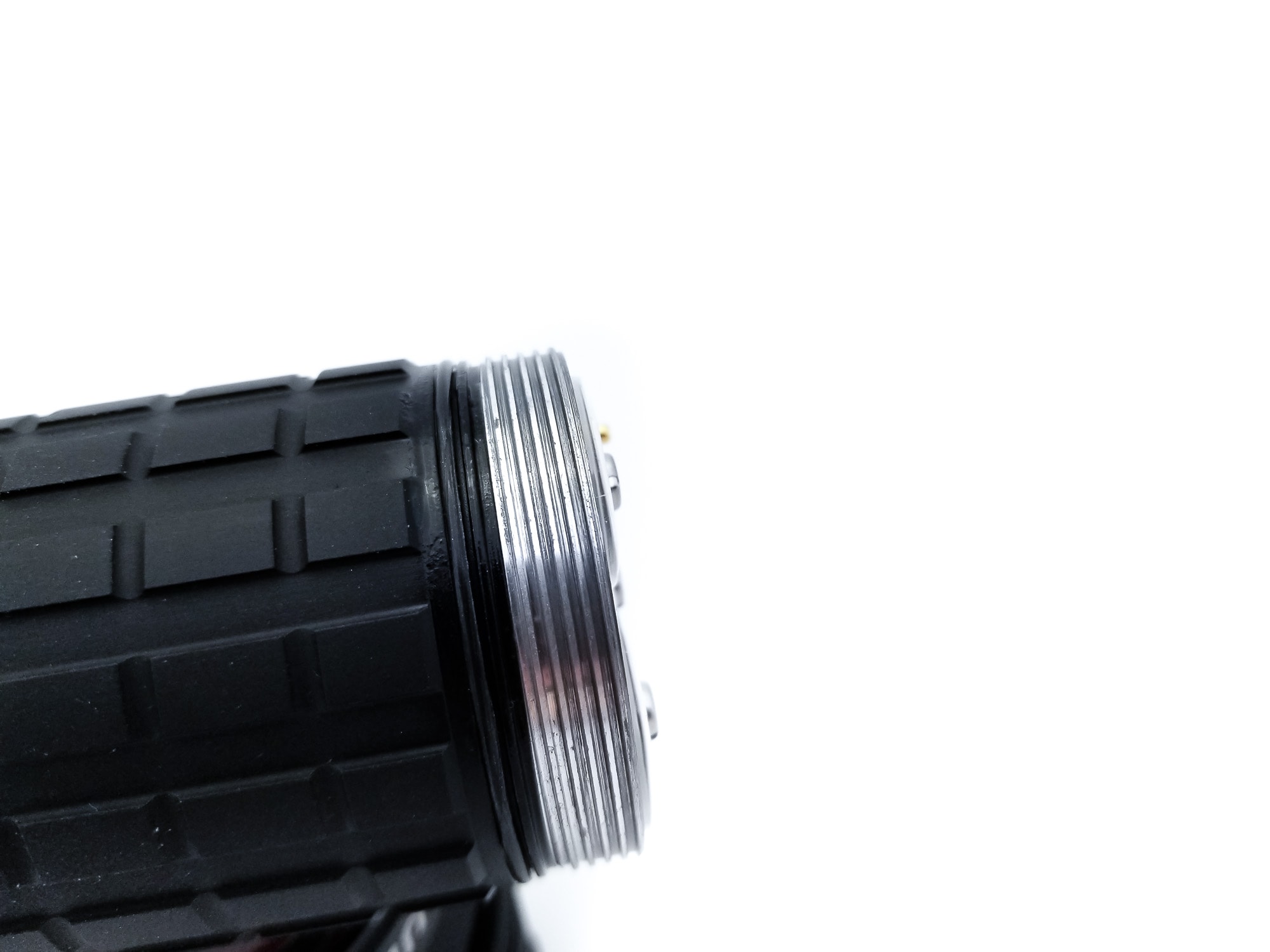
LED, Lens, Bezel, Beam, and Reflector
These days, if you want to make a lot of Lumens, a multi-LED setup is a must, usually either Cree XHP LEDs, or knockoffs. The Lumintop Mach adopts the former, and enlists 8 XHP50.2 LEDs for the light show. The XHP50.2 (and now joined by the XHP50.3) is a household name in the flashlight continuum, and for good reason. It’s a quad-die 5050-size LED and can be had in either 3v, 6v, or 12v configuration, in HD (domed), and HI (domeless). It’s a CSP design so it can be driven pretty hard without popping, and it’s pretty efficient across the CW bins with a low thermal resistance. It’s the 3 volt format that we see used most often since it’s easy to drive, and produces very high output (upwards of 4000 Lumens) when direct driven and properly cooled.
It’s also available in warmer tints and up to 90 CRI, but the majority of them are CW in consumer lights, and that’s what this one is. The downside of these LEDs is (like all gen 2 Cree products), is they suffer from angular tint shift and a generally ugly beam with a pee yellow corona and a bright hotspot. It’s obvious outdoors and indoors, and requires an OP reflector and creative AR coating to minimize it. The bezel is aluminum and the lens is recessed a bit for drop protection.
The Mach arranges the 8 LEDs in a circular pattern in 8 individual orange peel reflectors. They’re about 11 mm in diameter and fairly shallow. It’s topped with a piece of AR coated mineral glass with a hole in the middle for the fan air intake to pass through. This hole is sealed with an o-ring that glows in the dark, which is a nice touch.
The beam is all flood, with a nearly indiscernible hotspot surrounded by lots of spill. It really is a wall of light, similar to the Thrunite TN50 and Wurkkos TS32. This beam has surprising distance behind it though, so expect it to do well at 200+ meters. The beam has the typical (and expected) Cree ugliness, with a yellowish corona transitioning to the cool white bright center. The Opple Lightmaster Pro has the LEDs coming in at
- CCT: 5880K
- CRI Ra: 66 RA.
- Duv is 0.0057
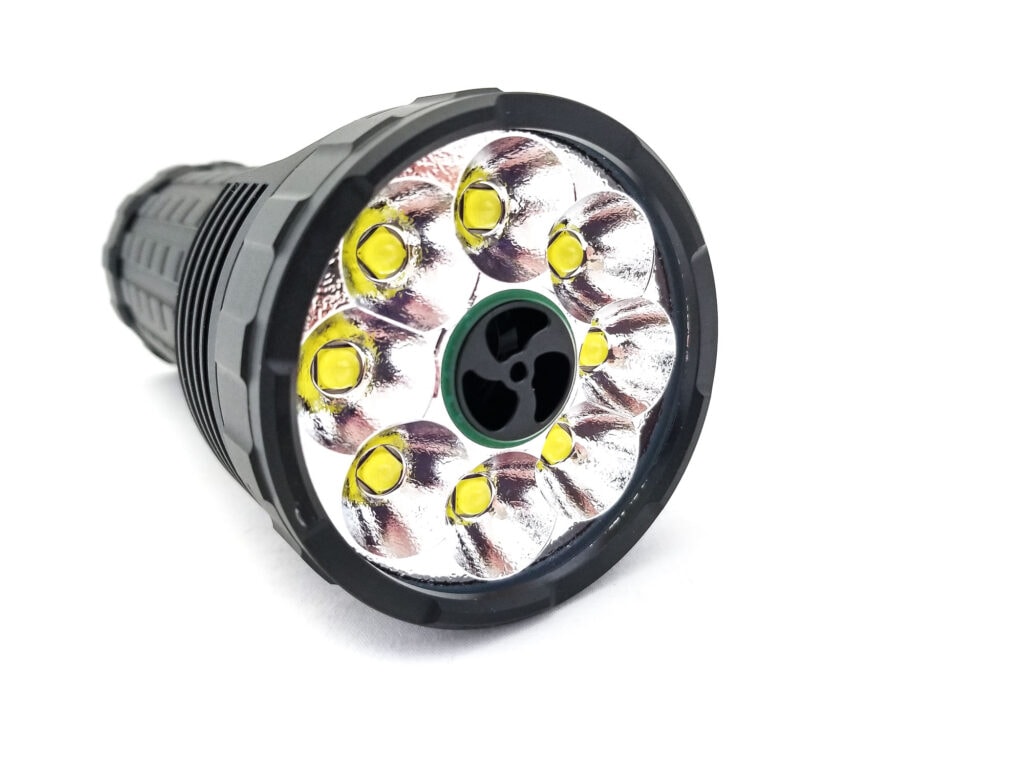
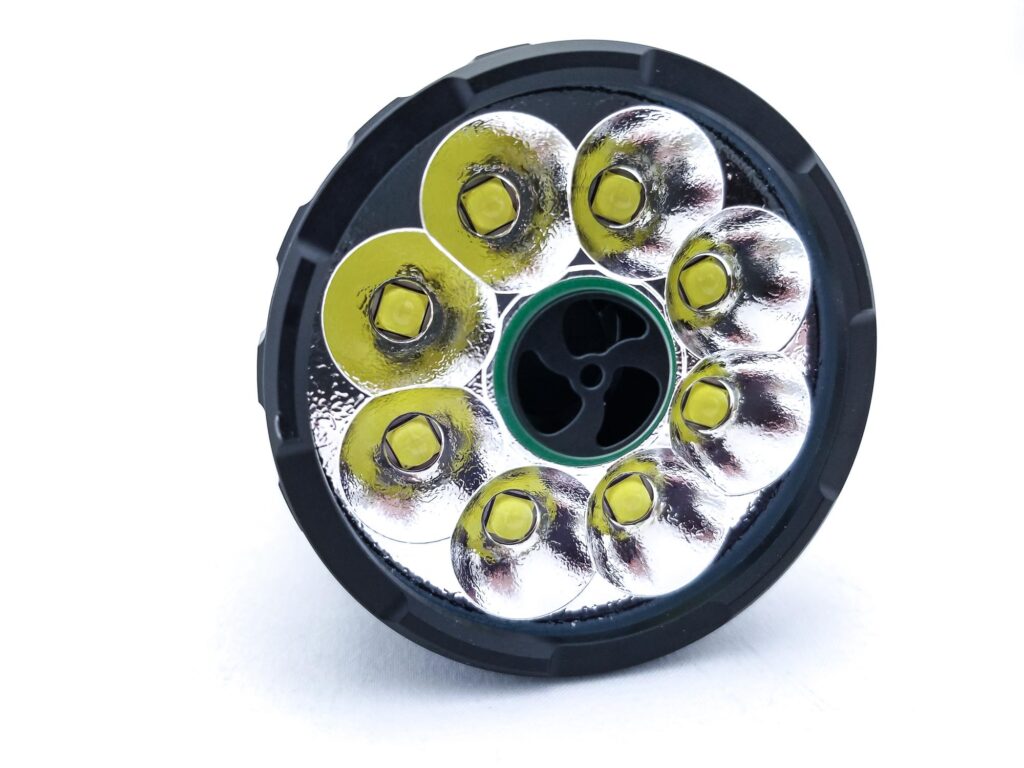
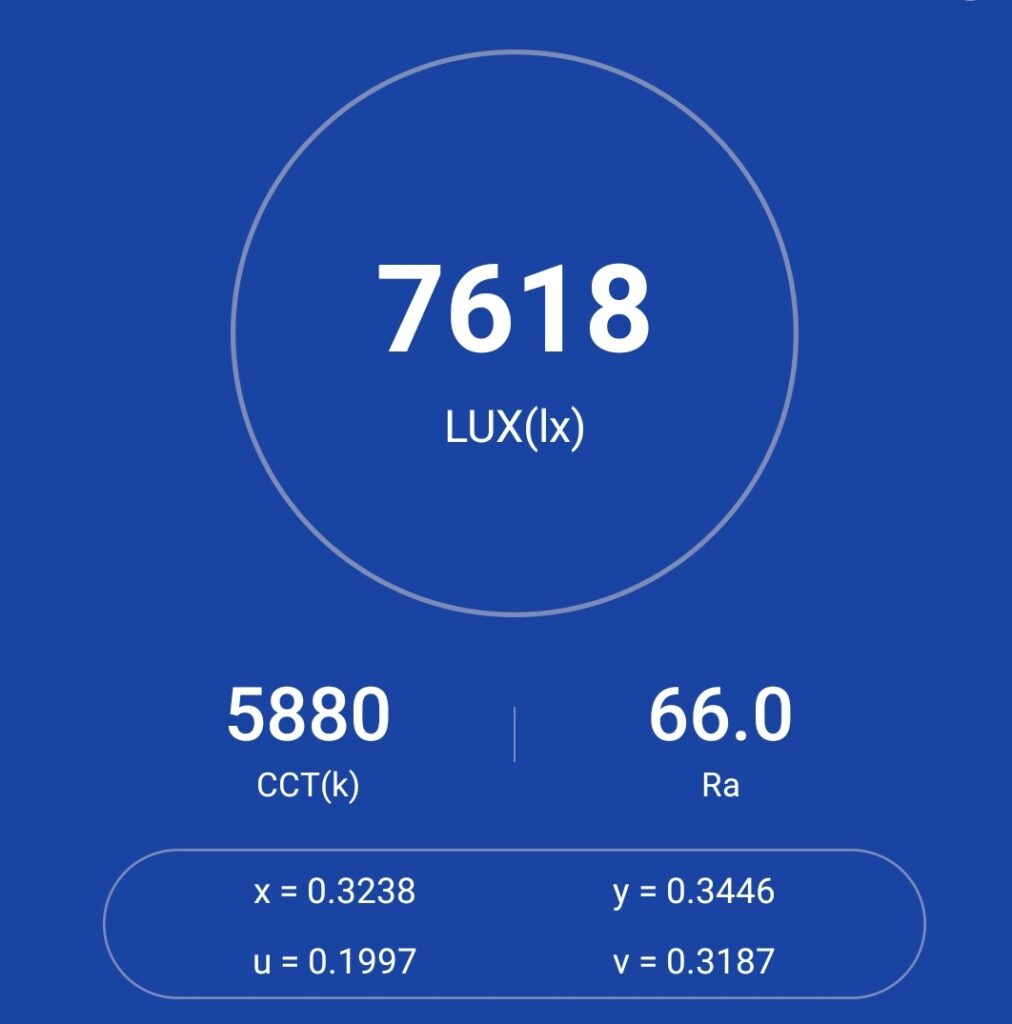
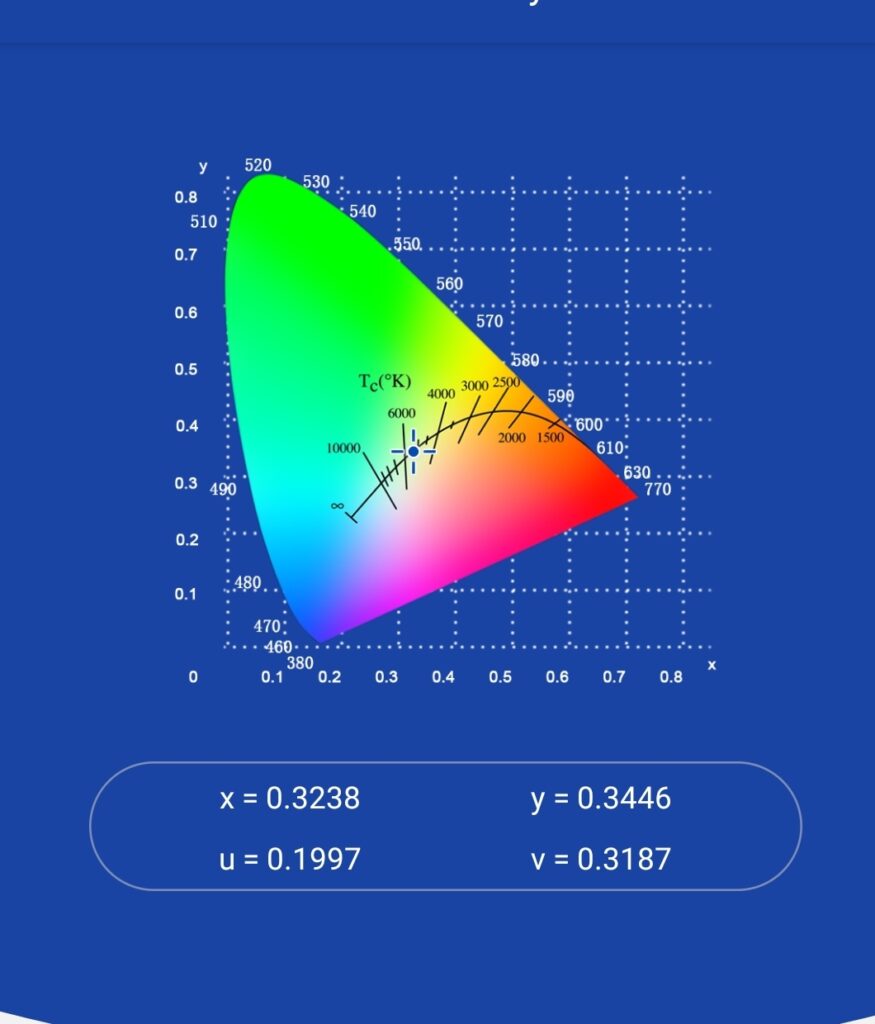
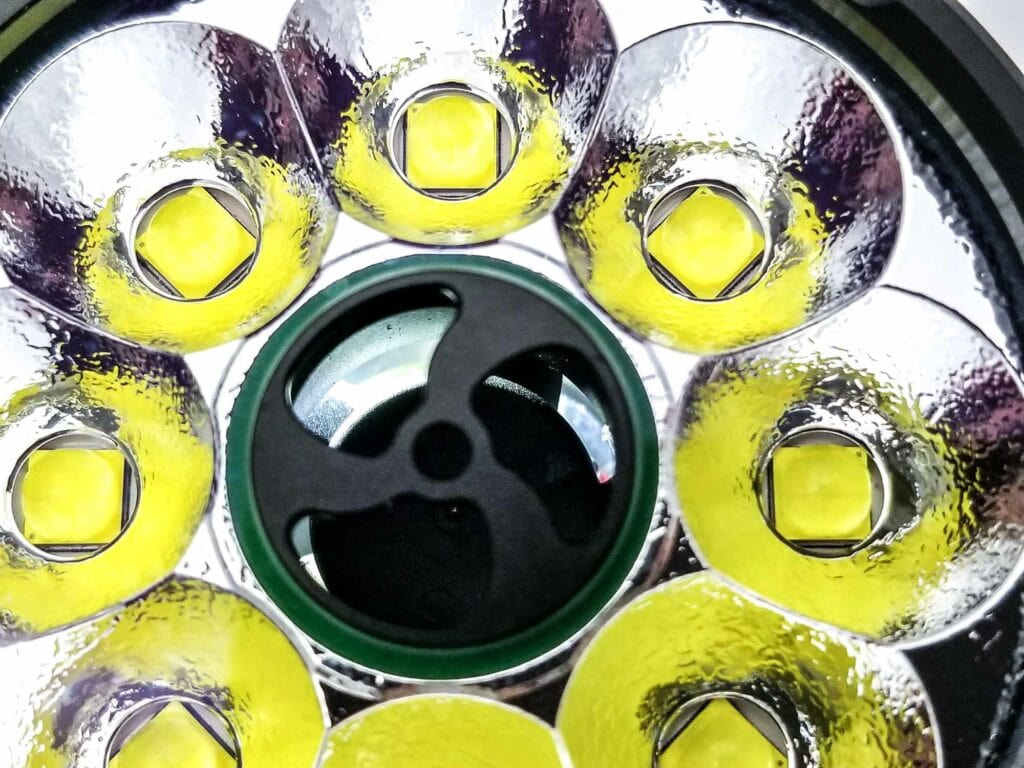
Dimensions and its competition
| Millimeters | Inches | |
|---|---|---|
| Length | 153 mm | 6 in |
| Head diameter | 68 mm | 2.7 in |
| Body diameter | 51 mm | 2 in |
Dimensions are rounded to the nearest millimeter, and to the nearest tenth of an Inch.
Weight:
| Weight in grams | Weight in oz | |
|---|---|---|
| Without battery: | 522 g | 18 oz |
| With 3x Molicel P42A batteries | 723 g | 25 oz |
Weight is rounded to the nearest gram, and to the nearest tenth of an Oz. For a chubby light, the Mach isn’t overly cumbersome. it’s relatively compact.
Flashlight size comparison with its competition:
Compared to some extremely bright flashlights
Group 1 left to right: Sofirn SP36 Pro, Wurkkos TS32, Lumintop Mach, Thrunite TN50
Group 2 left to right: Lumintop Mach, Thorfire C8, Nightwatch NS14
Group 3 left to right: Amutorch DM80, Lumintop Mach, Sky Ray King
Group 4 reflectors left to right: Amutorch DM80, Lumintop Mach, Wurkkos TS32
Group 5 top Lumintop Mach, bottom; Lumintop FWAA
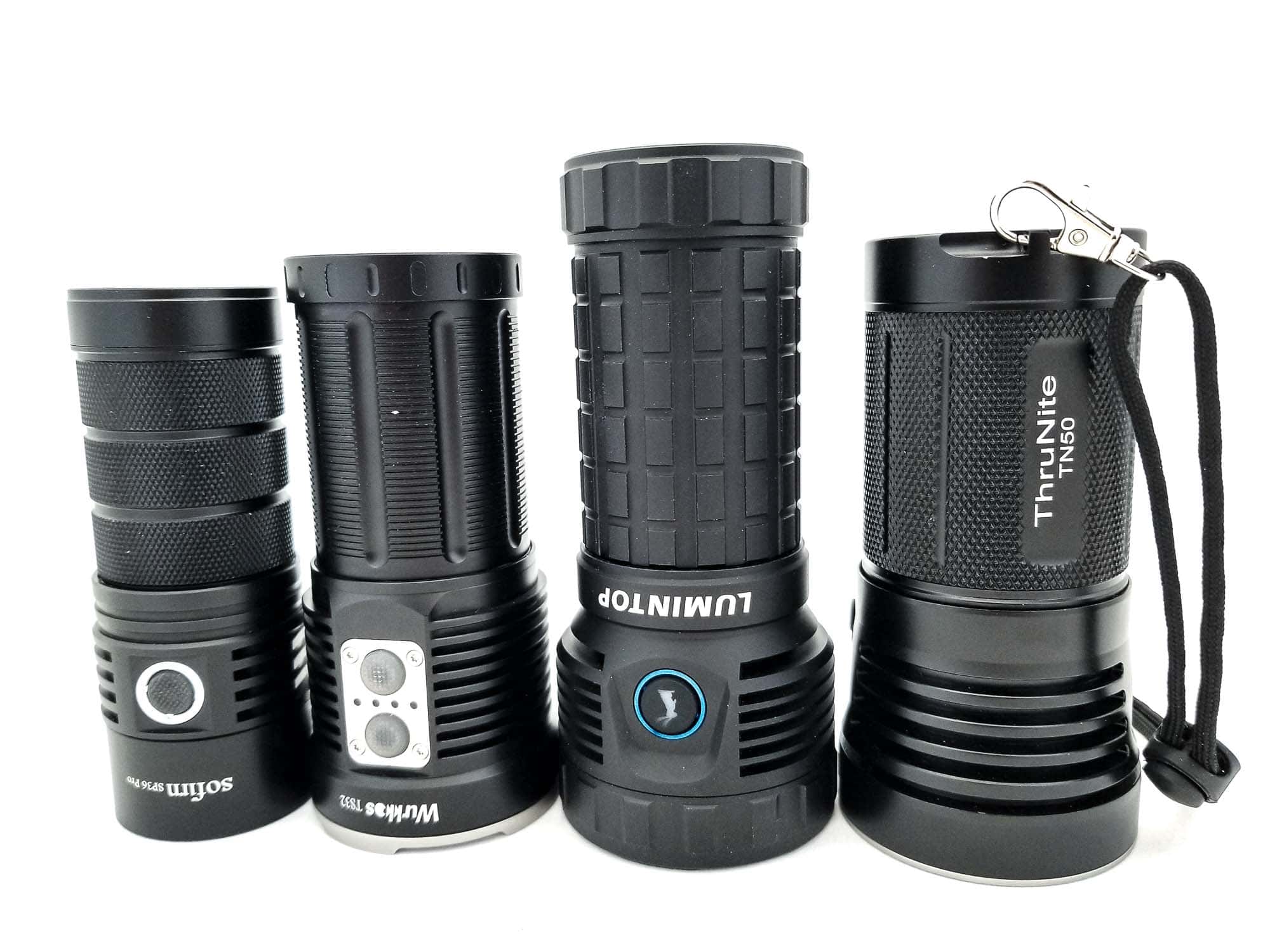
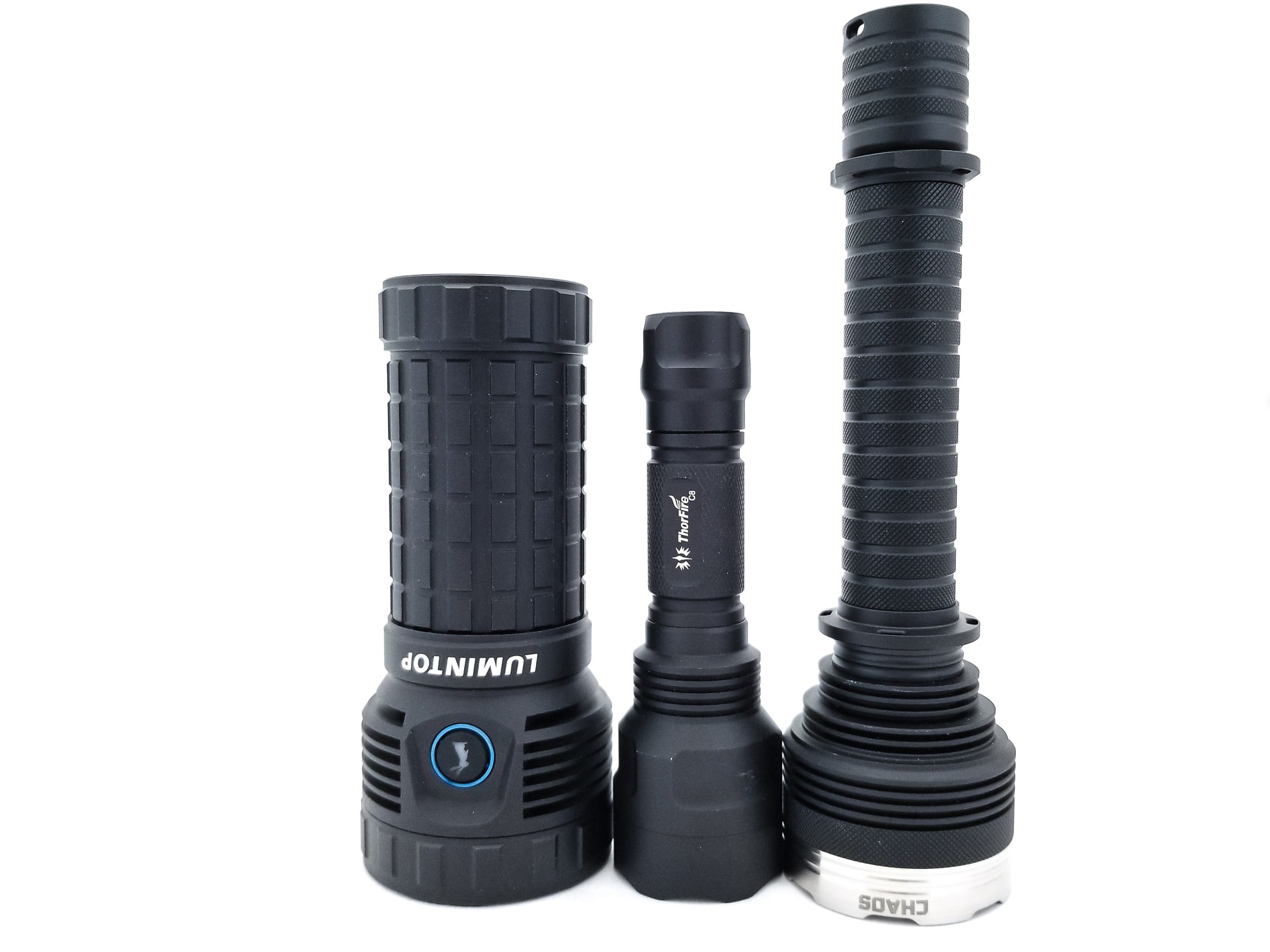
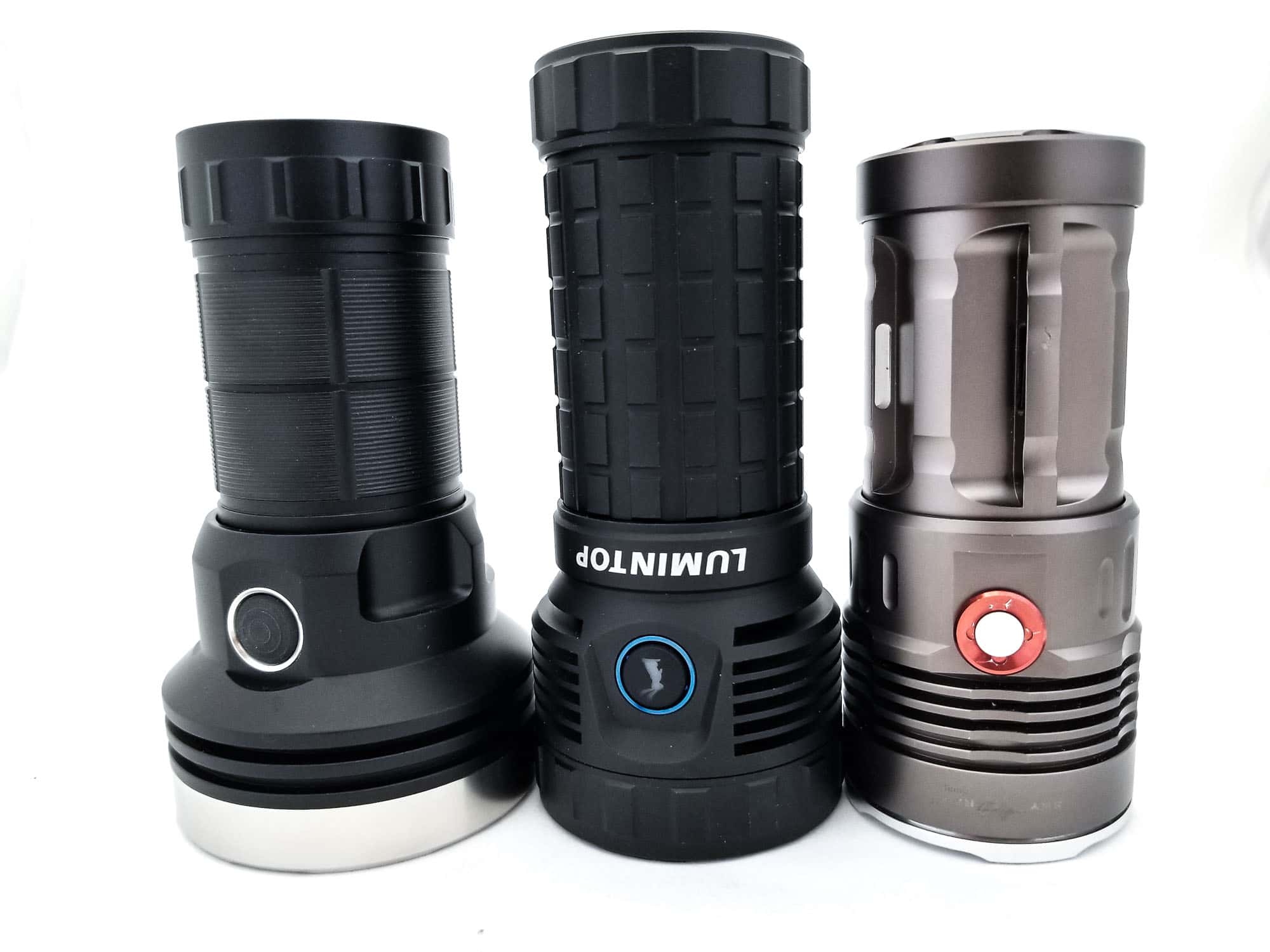
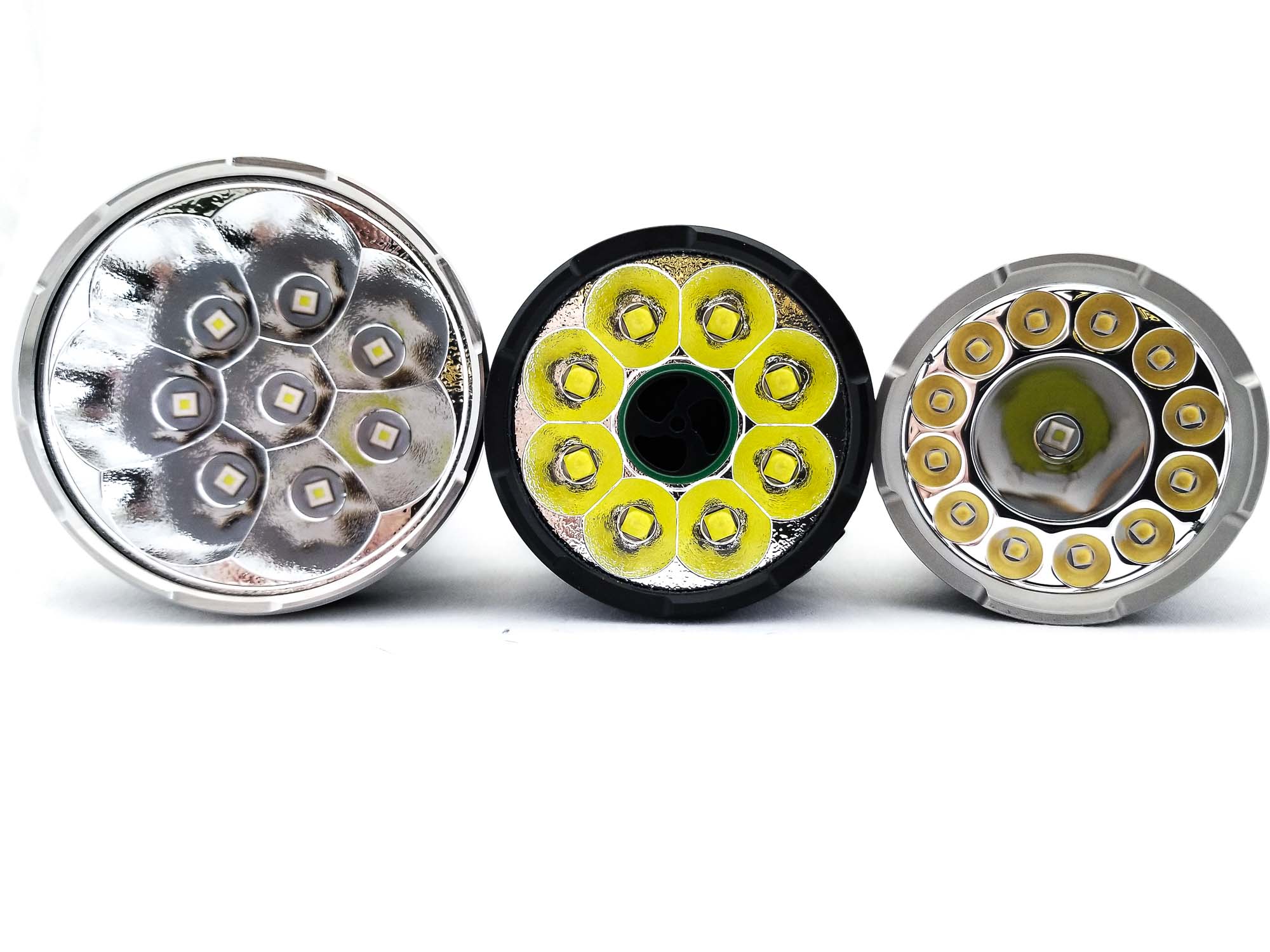
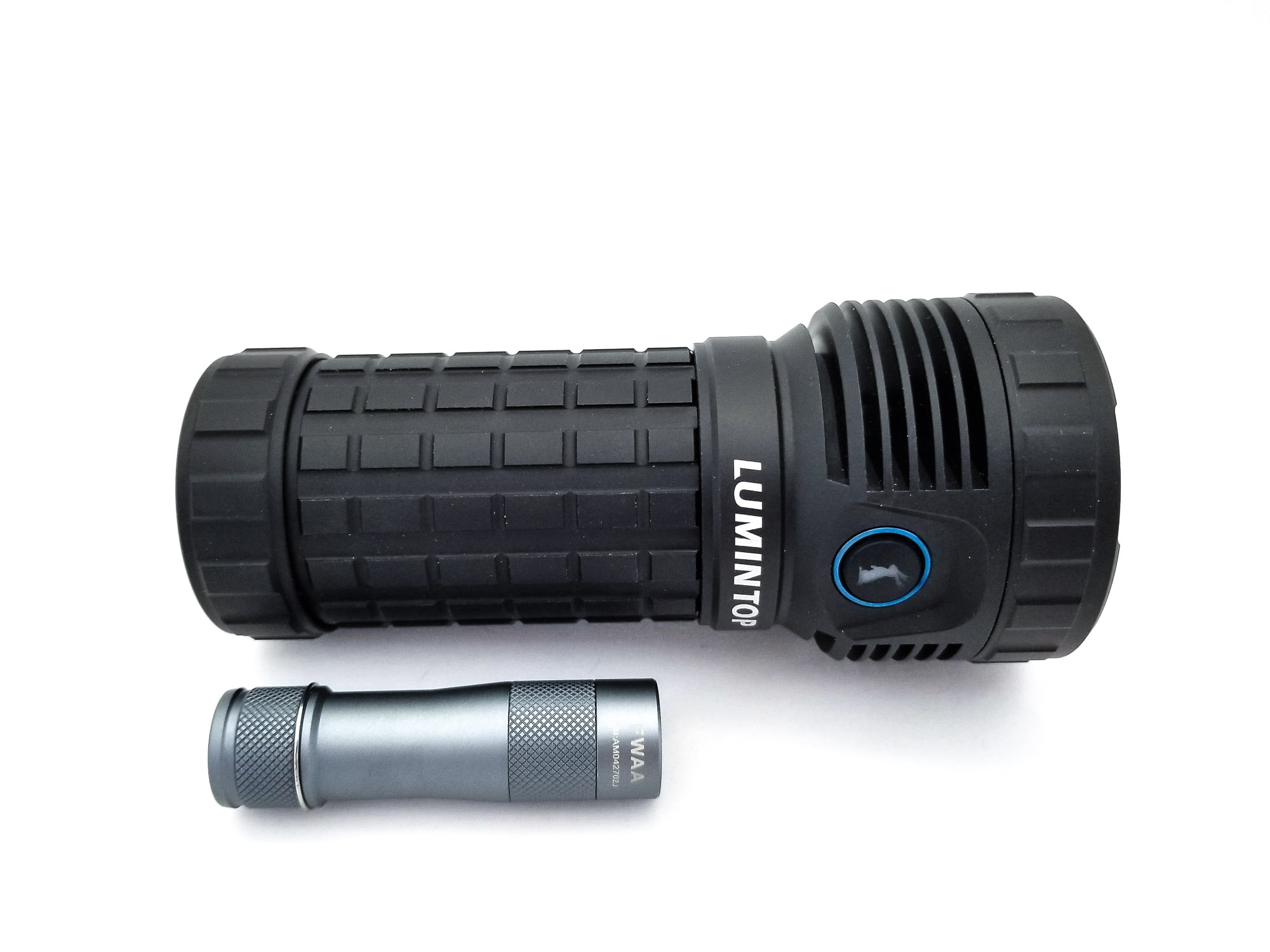
Lumintop Mach UI: User Interface and Driver
The driver is going to be a FET driver with a 7135 regulator for low and moonlight modes and a MOSFET controlled by PWM for direct drive. These drivers have a few advantages over a boost or buck driver, namely they’re cheap, easy to make, and can produce a lot of light. The disadvantage is the unregulated output, where the output drop tracks with the battery voltage drop. The UI follows the trend of other flashlight manufacturers, even those catering to the Anduril crowd of enthusiasts, by not flashing Anduril or Anduril 2.
That’s right, the Mach doesn’t have Anduril.
I can almost hear shouts of “Blasphemy! Blasphemy!”
Well, calm it down folks, since Lumintop did a good job here, and the Mach is sporting a decent UI. It’s a ramping UI, but it incorporates Moon, plus blinkies, and adds niceties like batt check, electronic lockout, and switch LED control.
Available modes:
- Smooth ramping with Moonlight, High 1 (top of ramp), High 2, Turbo
Available blinky modes:
- Strobe, SOS, Beacon
From OFF:
- Press and hold: Moonlight (double click in Moonlight for Strobe)
- Single click: Turns on in last memorized brightness level (only levels up to High 1 are memorized)
- Double click: High 2. To activate Turbo, double click while in High 2.
- 3 fast clicks: Battery check. Like with Anduril, the light blinks out the battery voltage, e.g. four blinks, a pause, and a single blink is 4.1 volts, three blinks, a pause, and eight blinks is 3.8 volts.
- 4 fast clicks: Electronic lockout
- 5 clicks turns turns fan on or off
- 7 clicks: Turns switch LED on or off
From ON:
- Press and hold: Ramps brightness up
- 1 click: Turns off
- Double click: High 2
- To activate Turbo, in High 2, double click the switch again
Mode memory:
- Remembers last brightness level up to High 1 (top of the ramp). Moon, High 2, Turbo and blinkies are not memorized
Shortcuts:
- To Moon: From off, long press switch for 1 second
- To Turbo: 2 clicks when in High 2 mode
- To Strobe: In Moonlight, double click to activate Strobe. To cycle through SOS and Beacon, double click again for each mode
Low voltage warning:
- ? The light will drop to a very low level when the batteries reach a certain low voltage (not specified in the manual)
Strobe/blinkies
- In Moonlight mode, double click to activate Strobe mode. Double click again for SOS and Beacon
Lock-out mode:
- From off, click the switch 4 times to activate lockout. Momentary Moonlight mode will be available in lockout. To deactivate lockout, repeat the 4 clicks.
Fan control
- From off, 5 clicks will activate or deactivate the fan. If deactivated, the fan will not come on in Turbo mode. The switch LED indicates the fan on/off as well: Blue is on, no blue…off.
PWM
- Yes, fast PWM not visible to the naked eye
Additional/summary info on the UI:
- I like this UI despite the fact it’s a bit quirky at times. I can’t complain much about the smooth ramping algorithm since it’s pretty good, and it’s simpler than Anduril. However, the omissions from that UI do not degrade the usefulness very much. Anduril die-hards, fan boys and girls might miss the ability to tweak stuff, but for the rest of us, it’s not a big deal. I like how Lumintop retailed the useful features of Anduril like switch backlight control, batt check, and electronic lockout here. I enjoyed the smooth ramping also. It strikes a bit of an in-between the very nice ramping speed of Anduril. The fan control is another nice touch, and some might find it very useful in cases where a noisy fan might not be welcome, or if you want to save energy and not run the fan. Lumintop says the fan is temperature controlled and comes on in Turbo mode (continuously), and when the temperature reaches a certain threshold on High 2. The fan should turn off when the temperature drops, but of course, the runtime test will keep the Mach honest.
Lumintop Mach Charging and batteries
Supplying almost 300 watts of power requires a stout power source, and these days that usually means multiples of 21700s. The Mach follows the trend of other high output soda can lights and utilizes three 21700 cells in parallel in that chubby battery tube. These are arranged in the usual way, with the positive end towards the head. Per Lumintop, the Mach accepts 21700s up to 72 mm long, and button tops are required, and if you buy the light from Neal, he sells the light with button top cells and it’s a good idea to get them, since it’s cheaper than sourcing and buying button top 21700s, which are surprisingly rare.
There’s actually a plastic disk in the middle of the driver PCB backside where the positive end of the battery and negative (ground ring) of the battery tube contacts. This is for reverse polarity protection to keep from nuking the light since it probably has zero input protection. To get the most out of the light, I recommend high drain batteries with at least a 35 amp CDR. You can use lower-output cells, but the output takes a huge hit.
For charging, the Mach borrows the charging layout from the Lumintop GT3 Pro and Thanos 23. To access the charging, you unscrew the tailcap, and underneath is a pretty trick charging setup, featuring two USB ports and a neat segmented LED information display. The two USB ports consist of a type C and USB type A.
Both ports are bidirectional, meaning they can accept charge input and charge output as a power bank. The type C port is PD 3.0 capable with adaptable output supporting 5v, 9 v and 12 volts up to 4 amps. The USB A port supports QC3.0, with up to 12 volts and 3 amps. The power bank can discharge at up to 5 V 3 A, or 15 watts. I plugged the Mach into a 45 watt PD power brick and on type C to type C it maxed out at about 12 v 1.4 amps and on a 18 watt QC3 charger I was getting about 8.9 volts and 1.89 amps on mostly discharged batteries. My USB tester shows 3 hours 28 minutes. I plugged in some PD capable flashlights (the Lumintop D3 and Nightwatch SupernValkyrie) and the D3 charged at 9 volts 1.7 amps and the Valkyrie maxed out at 12 volts 1.43 amps before it dropped out due to overload. This is pretty good charging speed on the power bank.
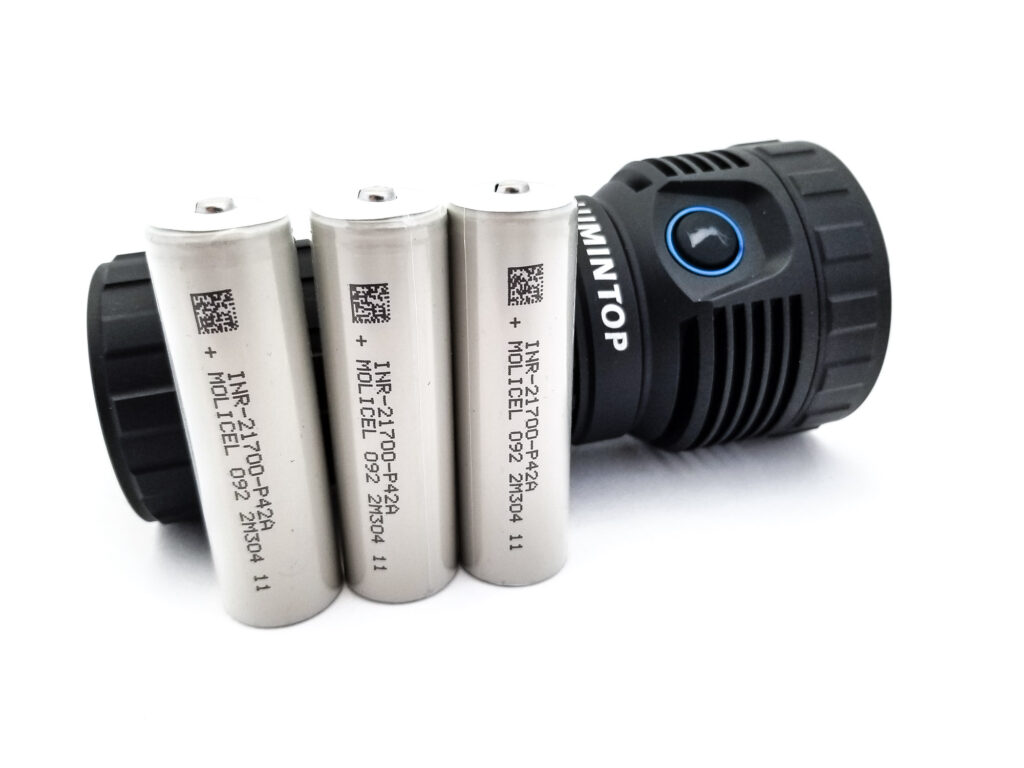

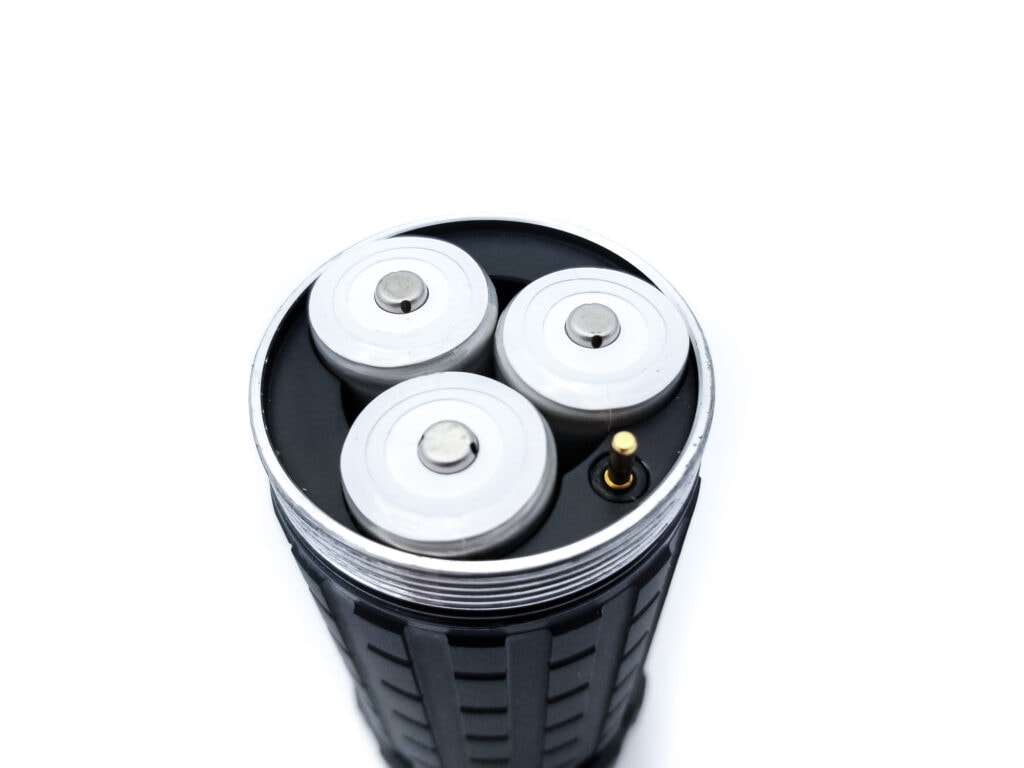
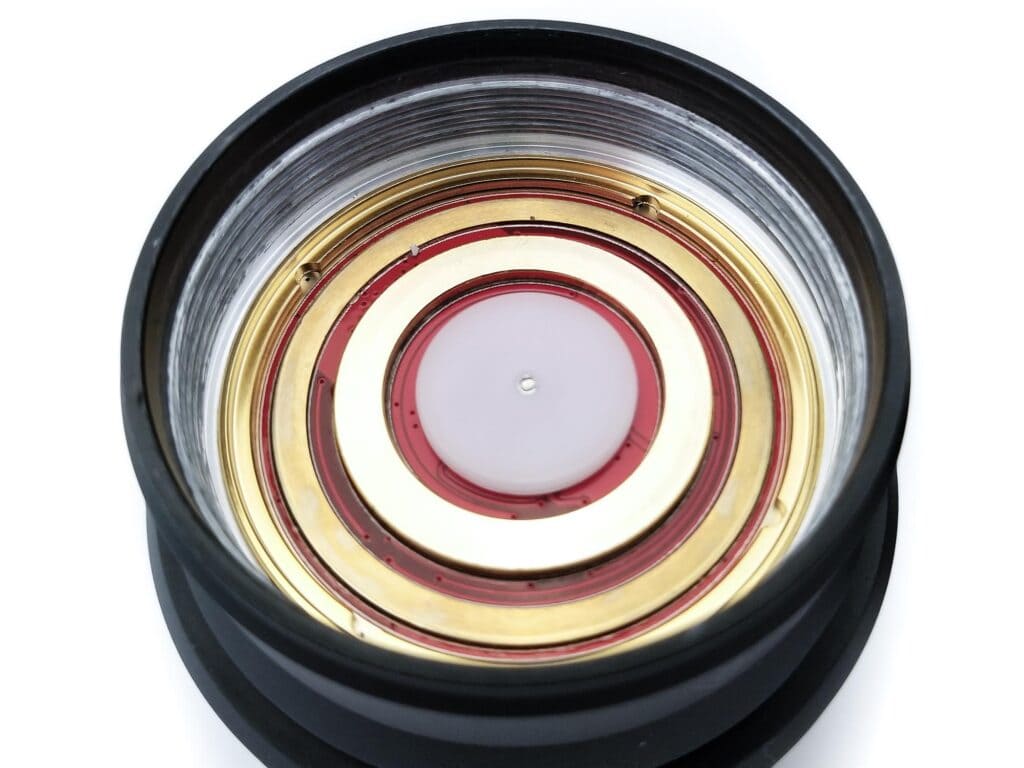
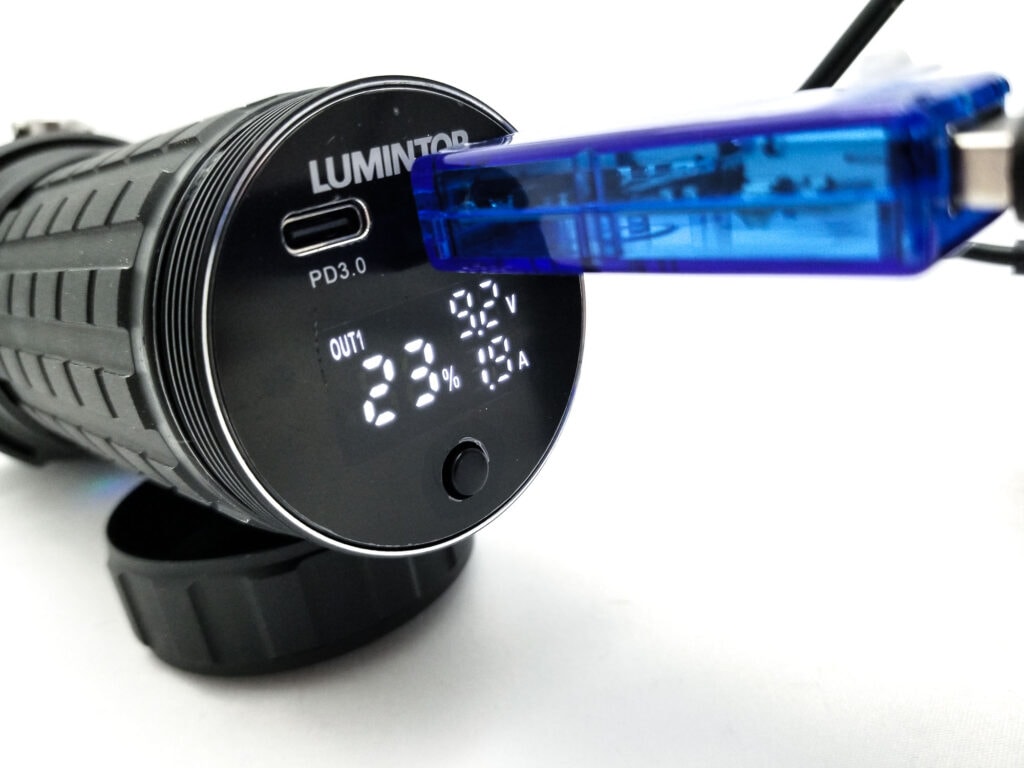
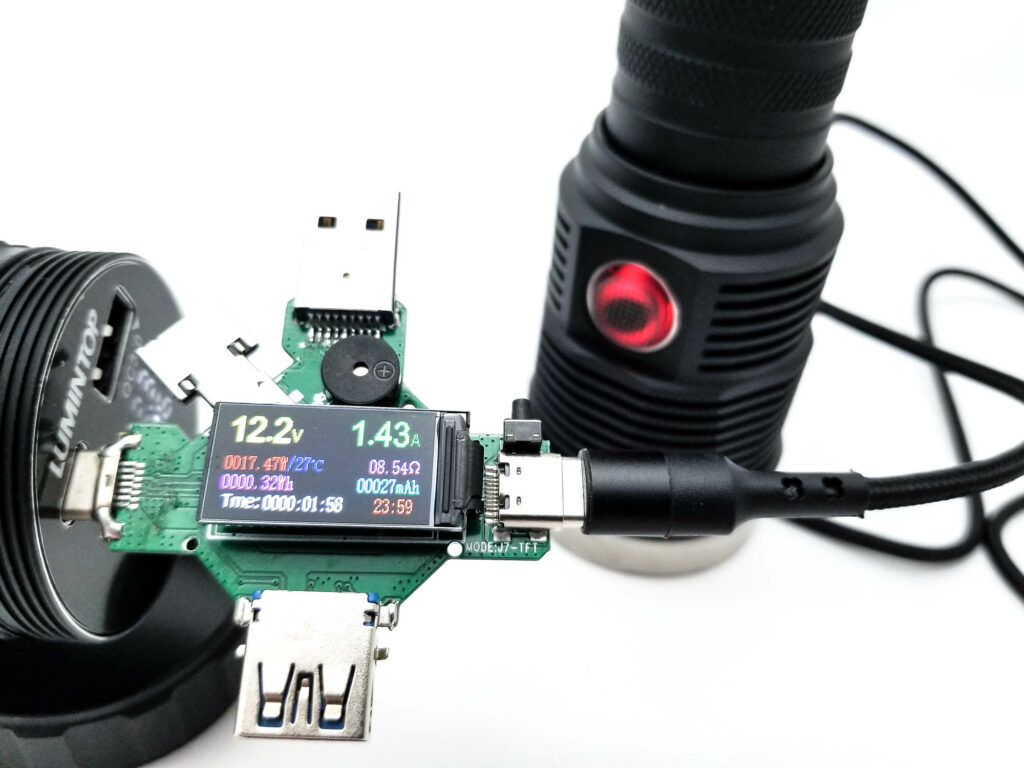
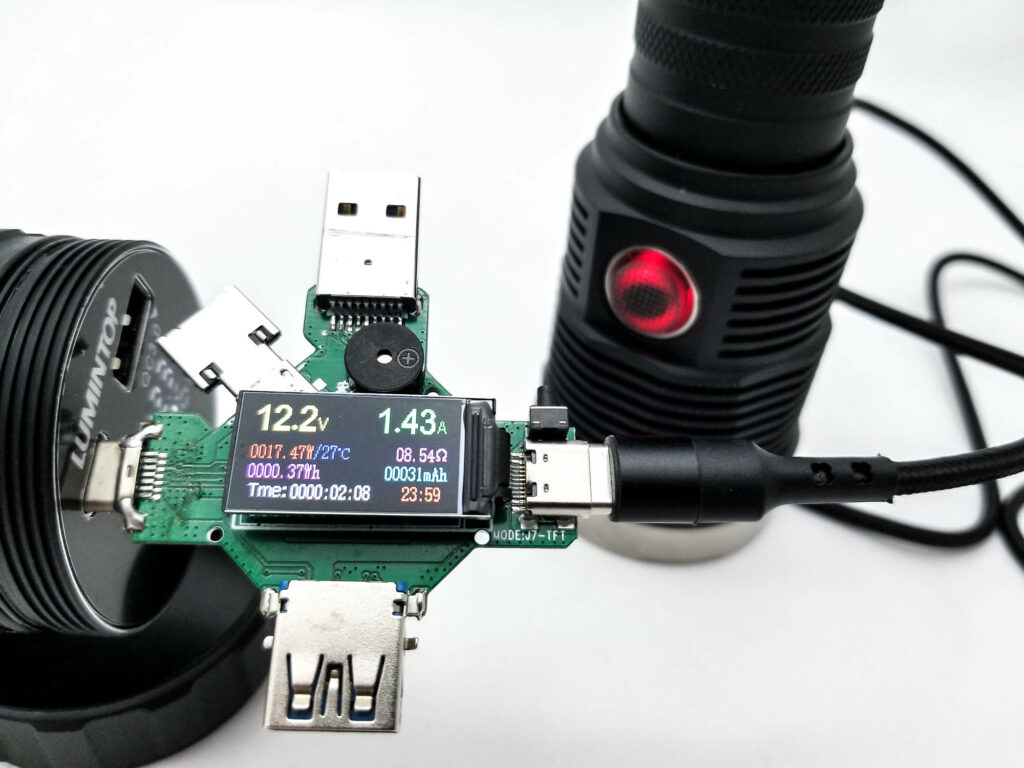
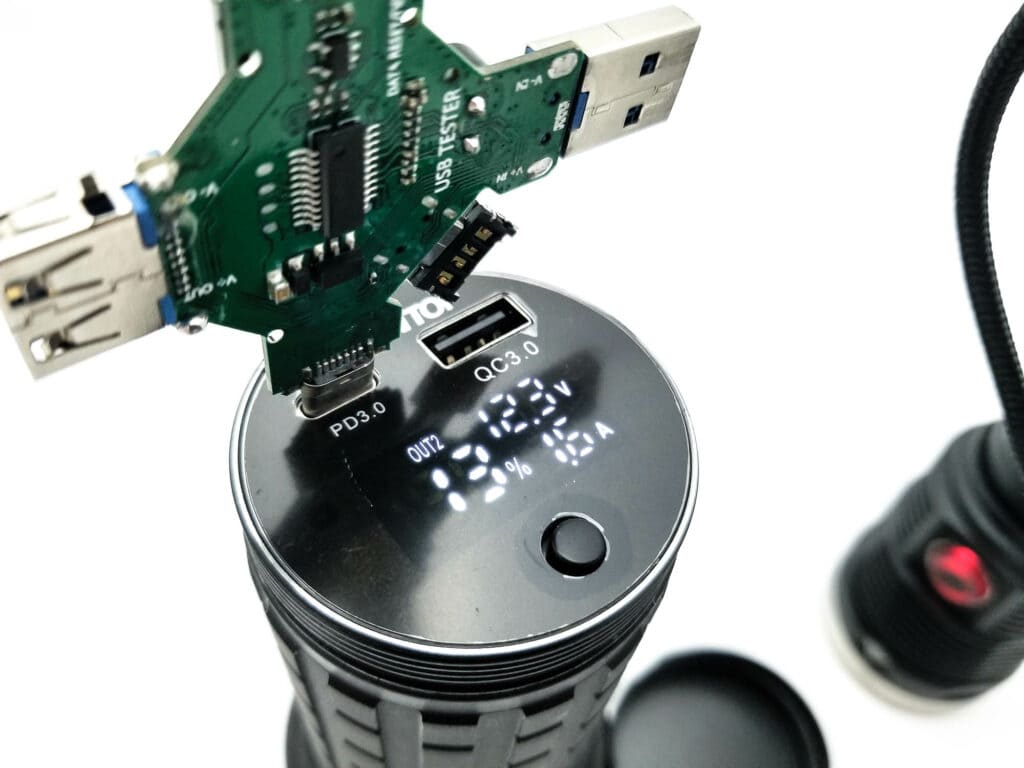
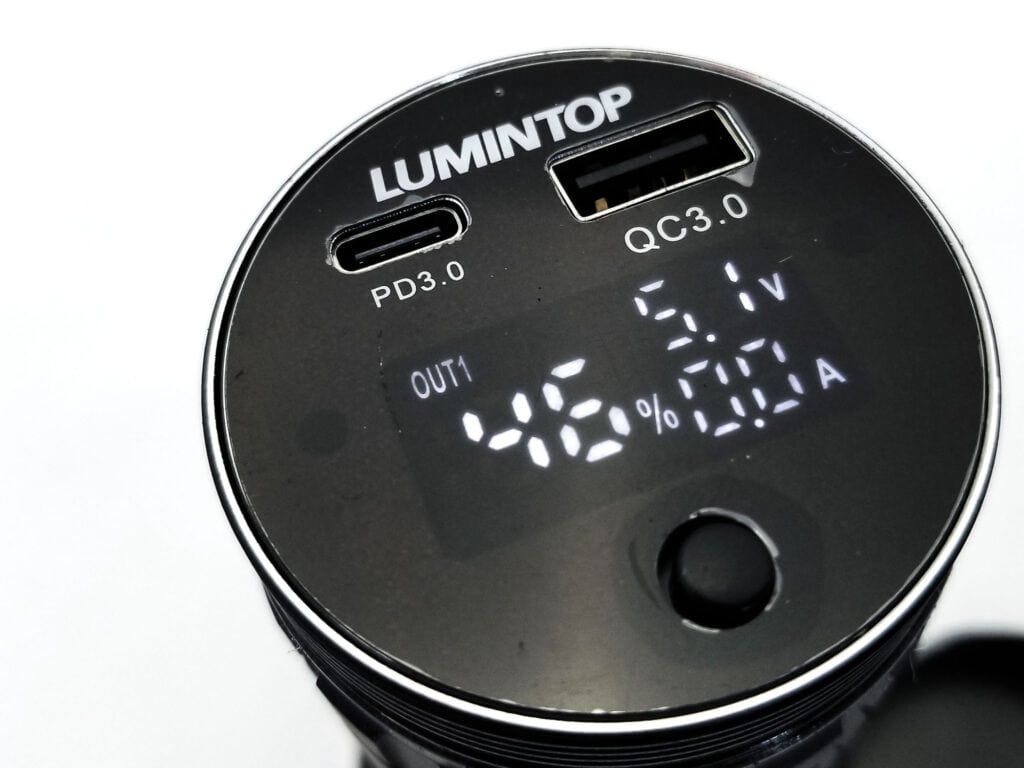
Performance test
Lumen measurements
How Lumens are Measured: Understanding ANSI FL1 Standards How Lumens are Measured: Understanding ANSI FL1 Standards: The ANSI FL1 standards specify that output in lumens should be measured 30 seconds after turning on, as this is the standardized time for measuring brightness according to the industry standard. This is why we focus on this part in our measurements. The ANSI FL1 standards require an ambient temperature of 22 ± 3°C. We record the ambient the ambient temperature to identify potential reasons for any observed discrepancies.Lumens are measured in my 50 cm integrating sphere with a Digi-Sense 20250-00 data logging luxmeter. The sphere has been calibrated with a Convoy S2+ measured to 260 Lumens and the figures are within 10% of actual. No current readings this time since measuring the current for soda can lights is both challenging and risky since accidentally shorting the input would make the Mach release the magic smoke that makes electronics stop working. I used the included Molicel P42A 4200 mAh batteries, fully charged, for the test.
Lumen measurements (for each mode)
| Mode | Specs | turn on | 30 sec | 10 minutes |
|---|---|---|---|---|
| Moon | 1 | N/A | N/A | – |
| Low (bottom of ramp) | ? | – | – | – |
| High 1 (top of ramp) | 2500 | 2386 | 2251 | 2251 |
| High 2 (fan on) | 8000 | 7380 | 7011 | 6150 lm |
| High 2 (fan off) | 8000 | 7380 | 7134 | 2091 |
| Turbo (fan on) | 26,000 | 22,107 | 19,830 lm | 6273 lm |
| Turbo (fan off) | 26,000 | 20,418 | 18,696 lm | 2091 |
Parasitic drain:
- Not tested
Lumintop doesn’t list an output spec for the bottom of the ramp, or what I’m calling Low mode. The manual lists the step down for the Turbo mode at 45 seconds with the fan on and 20 seconds with it off. With the fan running, the sustained output for Turbo after the step down should be 8000 Lumens for 1 hour. High 2 also steps down with the fan deactivated, but with the fan running, claims an 8000 Lumen sustained output for the entirety of the runtime. The fan on/off figures are really only relevant for High 2 and Turbo modes since they’re supposed to activate the fan when it reaches certain temperatures, and it runs continuously on Turbo mode.
In the test we saw it doesn’t meet specs, but still very impressive.
Lumintop Mach Battery Life: Runtime graphs
How Runtimes are Measured: Understanding ANSI FL1 Standards About ANSI FL1 runtime standards: The runtime is measured until the light drops to 10% of its initial output (30 seconds after turning on). This does not mean that the flashlight is not usable anymore. The last column shows how long the light actually works till it shuts off. If there is a + symbol, it means that the test was stopped at that particular point, but the light was actually still running. This happens on certain occasions, with certain drivers, firmware, or batteries.Runtimes are measured in my 50 cm integrating sphere with a Digi-Sense 20250-00 data logging luxmeter. The sphere has been calibrated with a Convoy S2+ measured to 260 Lumens and the figures are within 10% of actual. I measure temperature readings with my Digi-Sense 20250-92 data logging thermocouple. The thermocouple is affixed to the head with kapton tape, and I used the same 5 second sampling rate as the luxmeter. I used the included Molicel P42A 4200 mAh 21700s, fully charged, for the test. I ran the test with the fan on and off to see if Lumintop’s claims are indeed accurate.
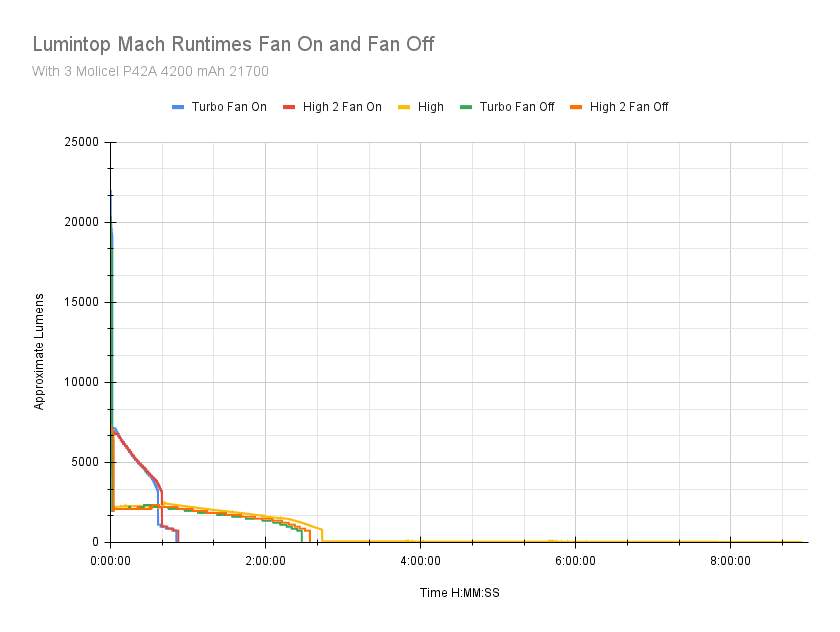
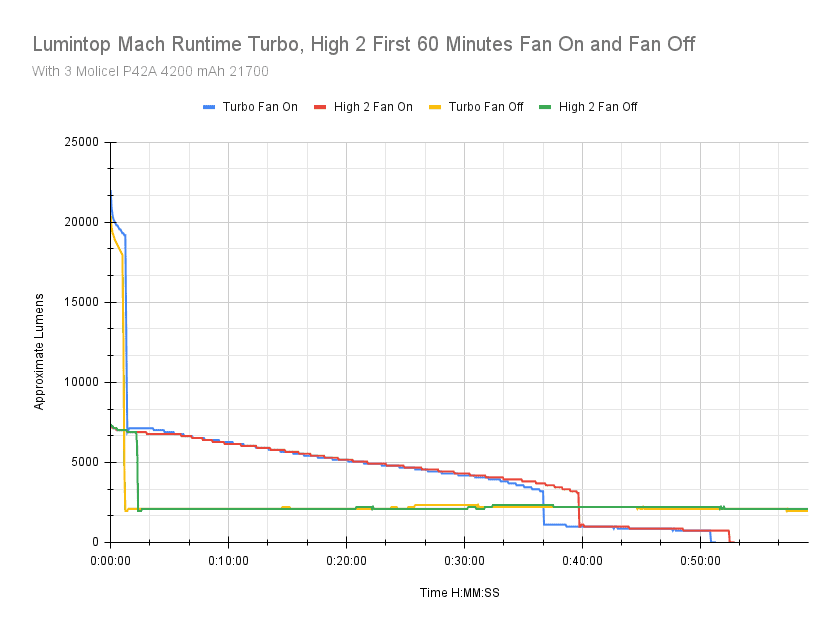
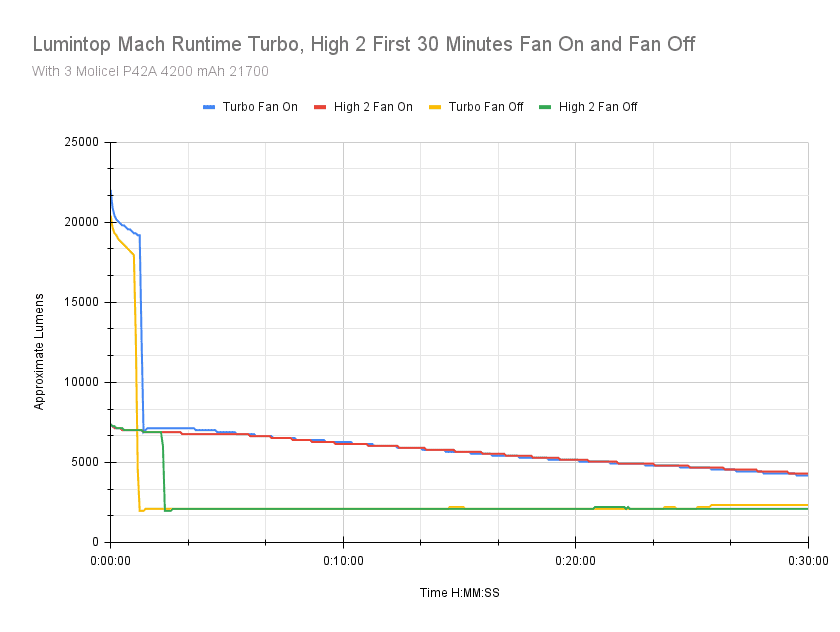
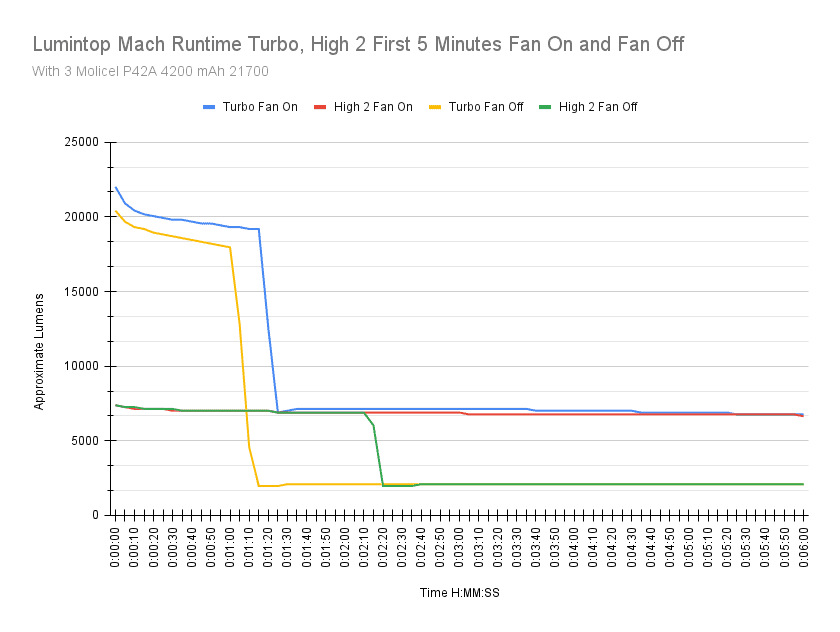
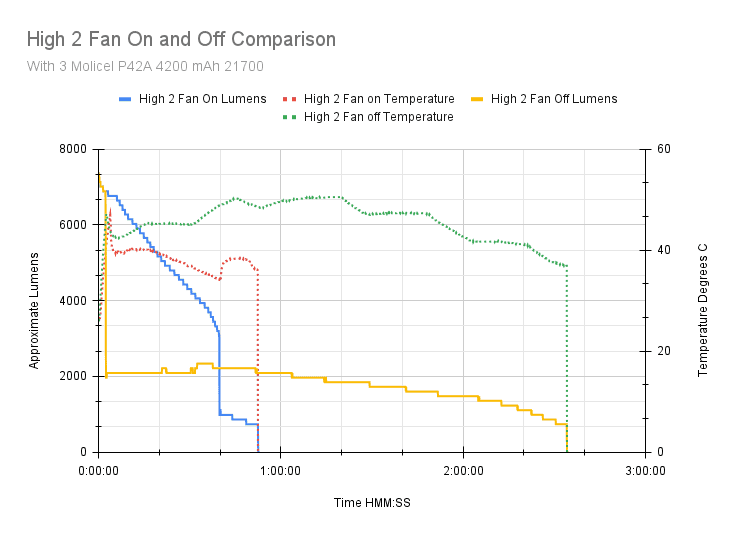
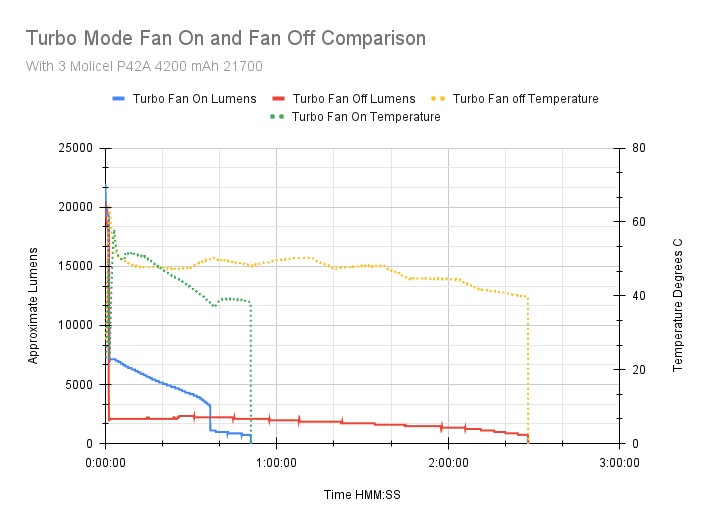
| Mode | Specified runtime | Measured runtime ANSI | Time till shut off |
|---|---|---|---|
| High (top of ramp) | 4h | 2h 43min | 8h 54m |
| High 2 (fan on) | 1h 10min | 48min 35s | 48min 35s+ |
| High 2 (fan off) | 3h 32min | 2h 30min | 2h 34min+ |
| Turbo (fan on) | 45s+1hr | 36min 45s | 50min 50s+ |
| Turbo (fan off) | 20s+1h | 1min 15s | 2h 27min+ |
Here’s where having an active cooling solution makes all the difference. A passive solution has a limited thermal capacity (the ability to transfer and dissipate heat). It must also be larger and therefore heavier. An active cooling solution accelerates the dissipation rate and which helps increase the thermal capacity without the need for extra thermal mass.
Compared to the passively cooled Thanos 23, the Mach shaves off 50 grams of weight (without batteries), and that’s a lot.
The Mach also holds maximum brightness on Turbo and High 2 for longer with a higher sustained output. The downside is that the runtime takes a (pretty big) hit due to the increased power consumption and higher sustained output. As far as the fan itself using excessive energy? While I can’t quantify that with testing, the fan does contribute to power drain, but all things considered, the Mach has a decided advantage over the Thanos 23 in terms of sustained output.
I put together some graphs with output and the associated thermal management with the fan off and on. With the fan on, it’s easy to see how having an active cooling source benefits sustained output on both High 2 and Turbo! Without the fan, the ANSI runtime for Turbo was a hair over 60 seconds. With the fan, it’s almost 40 minutes. At 10 minutes, on the fan the output is a bit over 6000 Lumens on High 2 and Turbo, compared to around 2000 Lumens with the fan off. Yep, that’s a lot. While the light still got pretty warm even with the fan on, it’s still hand-friendly for the majority of the runtime. The light ran until stepping down to a very low level, down to about 20 Lumens.
This wasn’t recorded on the Turbo and High 2 tests since I ended the tests for those modes as soon as the output dropped off the luxmeter due to it being out of range. The light was usable after each test at low levels, and the batteries read between 2.8 and 2.9 volts after the tests. Oh, in case you’re wondering, on High 2 the fan did activate by itself after about 10 minutes as the head reached around 60 C.
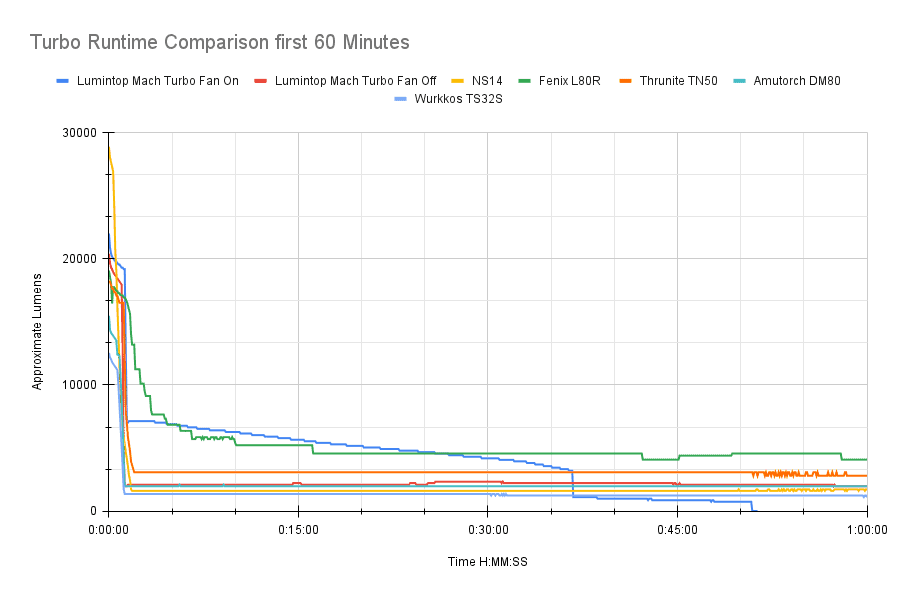
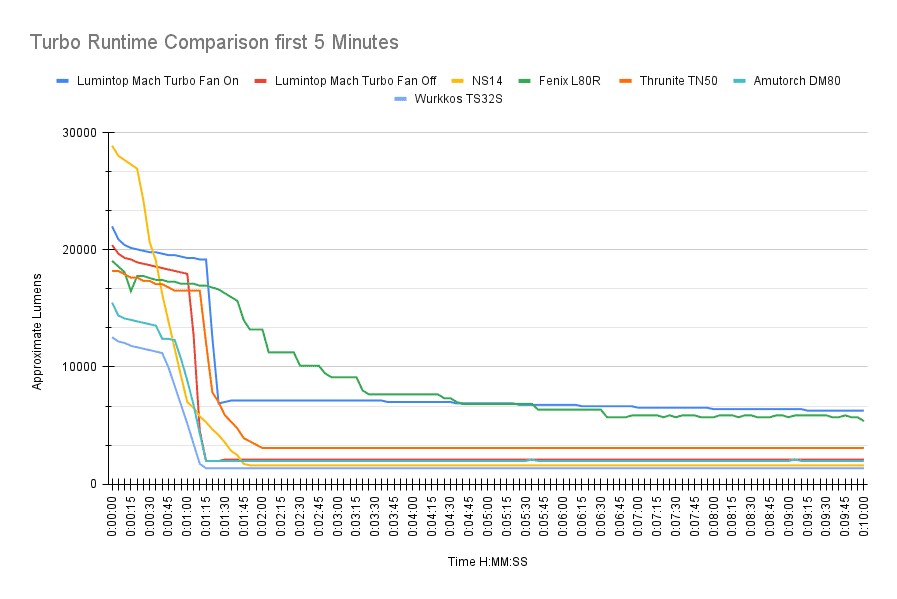
Peak beam intensity and beam distance measurements
About Peak beam intensity: Understanding ANSI FL1 Standards About peak beam intensity The calculated value of distance in meters at which the flashlight produces a light intensity of 0.25 lux. (0.25 lux is about the brightness of a full moon shining on an object). This means that the intensity has decreased so much, it becomes difficult to see darker objects, or objects that don’t reflect light. The columns ‘Meters’ and ‘Yards’ use rounded numbers.The beam distance test was conducted using the Uni-t UT383S luxmeter at a distance of 5 meters. I used the included Molicel P42A 4200 mAh batteries, fully charged, for the test. Measurements taken at 30 seconds per ANSI spec.
| Mode | Specs | Candela measured | Meters | Yards |
|---|---|---|---|---|
| Low (bottom ramp) | ? | N/A | N/A | N/A |
| High | ? | 6200 | 157 | 172 |
| High 2 | ? | 22,650 | 301 | 329 |
| Turbo (fan off) | ? | 57,650 | 480 | 525 |
| Turbo (fan on) | 67,500 | 66,450 cd | 515 | 563 |
Low was too dim at 5 meters to register on the luxmeter. Lumintop doesn’t list candela or distance figures for any mode except Turbo, with a 520 meter beam distance. I measured the beam distance with the fan on and off to see if it made a difference. It did! The fan definitely helps keep the candela up and the light from stepping down.
Beamshots
Photos taken with my Samsung Note 8 set to 0.3s ISO 200 and 5000K WB. The fence is 40 meters distant. You can see the difference in the different LEDs and reflector configurations.
Beamshots of the following flashlights compared:
- Lumintop Mach
- Thrunite TN50
- Wurkkos TS32
- Nightwatch NS14
- Nightwatch NS59v1
- Haikelite HT90
- Haikelite HK90
- Fenix LR80R









Disclaimer: This flashlight was sent to me for review at no cost by Nealsgadgets. I have not been paid to review, nor have I been holding back on problems or defects.
Final Verdict
Pros
- Decent build quality
- Active cooling solution really improves sustained output
- Affordable
- Great output and decent throw
- Simple Anduril-like ramping UI
- Fan is thermally controlled
Cons
- Unregulated driver
- Short runtimes on Turbo and High 2 with the fan on
- Fan only works in High 2 and Turbo
Explanation on star ratings:
1: Avoid: a match would be a better choice – 2: Poor: significant defect or issues; almost unusable – 3: Average: some defects or issues; but still usable 4: Good: recommended (minor issues) – 5: Great: highly recommended

4.5 stars: ★★★★⋆
While our star rating provides a reliable indicator, we encourage you to read the full review to make an informed decision based on your own needs and preferences.
Flashlight tech has come a long way in the last 5 years, and this has led to a proliferation of lights that have a lot of output. Making 25,000 Lumens is easy. Sustaining them is not. The solution? Make the lights bigger and add thermal mass, design a custom water cooler, or join the ‘fan club’ and add an active cooling solution.
Active cooled lights are still a bit of a rarity in the flashlight nexus, and I think that’s a shame since it’s the easiest way to improve a flashlight’s performance and aid in maintaining all those Lumens. Advances in electronics and design have allowed fan-cooled lights to stay relatively compact and lightweight, often coming in quite a bit lighter than passive-cooled lights of the same output.
Lumintop’s Mach, their entry into the ‘fan club,’ packages its fan in a unique way, with the fan inlet coming up through the lens, and I really like it, so major kudos to Lumintop for being bold with that. It also works, with the Mach putting up some pretty impressive sustained output figures for a relatively compact light, and I like how you can disable the fan, or let it come on automatically (in High 2 mode). The beam is impressively floody, and has equally impressive distance.
The UI? I really enjoy these UIs that take the best of Anduril and eschew the rest of the complicated bits. The Mach is not perfect though. The driver is unregulated and the output drops proportionally to the battery voltage. I get it that keeps the price down though. The fan, while not overly noisy, is still noisier than a passive cooled flashlight, so it’s something to get used to, and I with the fan would work in High mode also, since it gets pretty toasty after a while.
Lastly, while no fault of the light itself, the runtimes on High 2 and Turbo with the fan on really suffer as the light seemingly inhales the electrons from the batteries with prejudice. Those aside, I think the Mach is a step in the right direction for Lumintop. As a company with a long track record of innovative products, I’m glad to see them join the select few brands with an equally innovative fan-equipped light that actually works! 4.5 stars for the Mach.
Lumintop Mach discount code
Get yourself a great discount with our exclusive Nealsgadgets discount coupons: 1LumenNew or 1Lumen711
1lumen selects and reviews products personally. We may earn affiliate commissions through our links, which help support our testing.